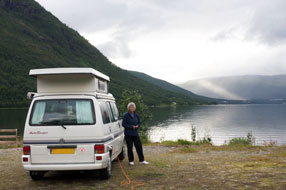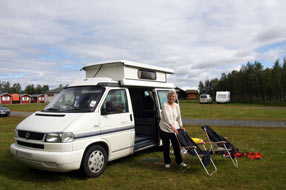|
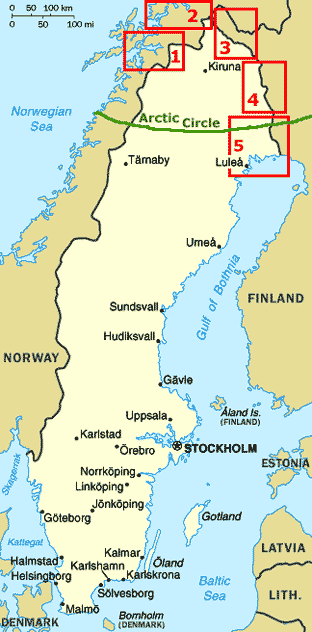 CAMPING
IN NORTHERN NORWAY, NW FINLAND, and SWEDEN 2013 - across into Northern Norway, the iron ore port of Narvik, north
to Tromsø, across
the fjords to Skibotn, Kilpisjärvi in NW Finland, return to Northern Sweden at
Karesuando and down the Tornedalen valley to Pajala, south to re-cross the
Arctic Circle in the Kalix Valley: CAMPING
IN NORTHERN NORWAY, NW FINLAND, and SWEDEN 2013 - across into Northern Norway, the iron ore port of Narvik, north
to Tromsø, across
the fjords to Skibotn, Kilpisjärvi in NW Finland, return to Northern Sweden at
Karesuando and down the Tornedalen valley to Pajala, south to re-cross the
Arctic Circle in the Kalix Valley:
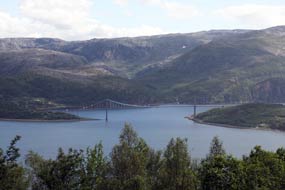 Into Northern Norway to Narvik: with
cheerless Arctic grey cloud obscuring the surrounding fells, we crossed the
open border into Norway just beyond Riksgränsen; immediately we were in a
different world leaving behind the high plateau fell-scape of Sweden and soon
starting a steep descent in severely mountainous terrain surrounded by imposing
snow-flecked peaks. The narrow road rounded into a craggy ravine, wispy cloud
hovering around the backdrop of peaks as we descended steeply towards the
fjord-inlet to approach the junction with the main E6 highway. Turning south to
cross the suspension bridge over the fjord narrows (see left), we headed along the southern
loch-shore towards Narvik, surprised at the stark mountainous countryside
surrounding the little port which snuggled into the inner fjord with peaks
rising steeply on all sides. Into Northern Norway to Narvik: with
cheerless Arctic grey cloud obscuring the surrounding fells, we crossed the
open border into Norway just beyond Riksgränsen; immediately we were in a
different world leaving behind the high plateau fell-scape of Sweden and soon
starting a steep descent in severely mountainous terrain surrounded by imposing
snow-flecked peaks. The narrow road rounded into a craggy ravine, wispy cloud
hovering around the backdrop of peaks as we descended steeply towards the
fjord-inlet to approach the junction with the main E6 highway. Turning south to
cross the suspension bridge over the fjord narrows (see left), we headed along the southern
loch-shore towards Narvik, surprised at the stark mountainous countryside
surrounding the little port which snuggled into the inner fjord with peaks
rising steeply on all sides.
|
Click on the 5 highlighted areas of map for
details of
Norwegian and
Finnish borders |
 |
Arriving at the iron ore port of Narvik:
in dreary light and low cloud we entered the town's outskirts passing tonight's
campsite Narvik Camping, and along the main street of Kongens Gate we pulled
into the station
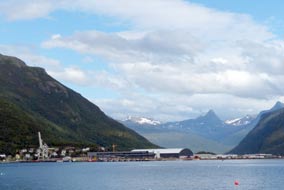 forecourt to check times of trains for our planned rail journey
tomorrow on the Malmbanan/Ofotbanen back up to the Swedish border at Riksgränsen.
The TIC at the station provided a street plan and weather forecast: after a
brief sunny spell tomorrow, the outlook for our stay in Northern Norway was
pessimistically gloomy and wet. Driving around through the town, Narvik's
harbour was dominated by the huge LKAB iron ore terminal on the opposite side of
the fjord with its metallic mass of chutes and piles of rust-coloured ore. On
the far side of the town, the E6 passed through a 2km long tunnel under the
mountains, crossing a side-fjord on a long bridge to a more industrial area
where we found a Rema 1000 supermarket to re-stock with provisions, a
reminder shock of Norwegian food prices. Driving back into the town centre gave
us a full impression of the little port-town nestled around the fjord and
spreading up onto the lower reaches of the surrounding high mountains. Bulk ore
ships were anchored out in the enclosed harbour-fjord awaiting loading with iron
ore transported by train down from the mines at Gällivare and Kiruna (see left). forecourt to check times of trains for our planned rail journey
tomorrow on the Malmbanan/Ofotbanen back up to the Swedish border at Riksgränsen.
The TIC at the station provided a street plan and weather forecast: after a
brief sunny spell tomorrow, the outlook for our stay in Northern Norway was
pessimistically gloomy and wet. Driving around through the town, Narvik's
harbour was dominated by the huge LKAB iron ore terminal on the opposite side of
the fjord with its metallic mass of chutes and piles of rust-coloured ore. On
the far side of the town, the E6 passed through a 2km long tunnel under the
mountains, crossing a side-fjord on a long bridge to a more industrial area
where we found a Rema 1000 supermarket to re-stock with provisions, a
reminder shock of Norwegian food prices. Driving back into the town centre gave
us a full impression of the little port-town nestled around the fjord and
spreading up onto the lower reaches of the surrounding high mountains. Bulk ore
ships were anchored out in the enclosed harbour-fjord awaiting loading with iron
ore transported by train down from the mines at Gällivare and Kiruna (see left).
Narvik War Memorial Museum recalling the
1940 German invasion: back into the centre on a gloomy Saturday
afternoon, we pulled in at the Nordland Røde KorsKrigsminne-museum (Red Cross
War Memorial Museum) which documents the tragic events of April~June 1940 with
the German invasion of Narvik to seize the iron ore supply, the Allies'
counter-attack, the naval battle in the harbour and the fighting in the
mountainous hinterland to stem the German advance. The displays also detail life
in Narvik under 5 years of German occupation after the Norwegian government's
capitulation on 10 June 1940 and the regaining of freedom in May 1945. Before
April 1940, neutral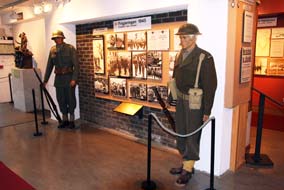 Sweden had been supplying the Allies with iron ore via the
ice-free port of Narvik. The Germans had sent a fleet of 10 destroyers which in
early April 1940 had entered the port, sunk 2 antiquated and outgunned Norwegian
naval ships and captured the iron ore docks and loaded ore carriers in the
harbour. The following day, a fleet of 5 Royal Navy destroyers reached Narvik
and a fierce naval battle was fought in the harbour with ships on both sides
being sunk. A larger RN fleet arrived, landing British, French and Polish troops
who recaptured the town, driving the Germans into the mountains. Fierce fighting
took place in the mountainous terrain up towards the Swedish border between the
heavily armed Germans and poorly armed Norwegians. The Germans pounded Narvik
with naval bombardment and saturation bombing sinking more vessels in the
fjord-harbour; the Allied forces suffered severe casualties and were hurriedly
evacuated with Hitler's invasion of France in June 1940. The civilian population Sweden had been supplying the Allies with iron ore via the
ice-free port of Narvik. The Germans had sent a fleet of 10 destroyers which in
early April 1940 had entered the port, sunk 2 antiquated and outgunned Norwegian
naval ships and captured the iron ore docks and loaded ore carriers in the
harbour. The following day, a fleet of 5 Royal Navy destroyers reached Narvik
and a fierce naval battle was fought in the harbour with ships on both sides
being sunk. A larger RN fleet arrived, landing British, French and Polish troops
who recaptured the town, driving the Germans into the mountains. Fierce fighting
took place in the mountainous terrain up towards the Swedish border between the
heavily armed Germans and poorly armed Norwegians. The Germans pounded Narvik
with naval bombardment and saturation bombing sinking more vessels in the
fjord-harbour; the Allied forces suffered severe casualties and were hurriedly
evacuated with Hitler's invasion of France in June 1940. The civilian population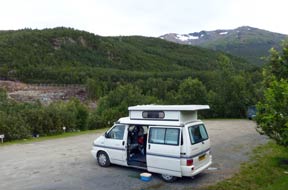 had suffered badly during the fighting and bombing and much of the town was
destroyed as well as the port installations and iron ore terminal. With the
Norwegian government's capitulation in June, the Norwegian forces were forced to
surrender despite having pinned down superior German forces in the mountains,
and Narvik now suffered under 5 years of German occupation; Hitler had access to
the Swedish iron ore supply.
had suffered badly during the fighting and bombing and much of the town was
destroyed as well as the port installations and iron ore terminal. With the
Norwegian government's capitulation in June, the Norwegian forces were forced to
surrender despite having pinned down superior German forces in the mountains,
and Narvik now suffered under 5 years of German occupation; Hitler had access to
the Swedish iron ore supply.
The War Memorial Museum's detailed displays
gave a moving account of the lead up to the German invasion, including detailed maps of the disposition of both Norwegian and Swedish forces, the
various stages of both naval and land battles around Narvik, and final surrender
of the port-town followed by 5 years of occupation until Norway's liberation in
May 1945. Leaving aside all the military hardware and exact details of the
fighting difficult to follow with the translation booklets, this was a worthy
little museum telling the story of one of the earliest and little known Allied
engagements of WW2 with such tragic consequences both for the small Allied force
and the civilians of Narvik. Leaving the museum with grey cloud now down to
fjord-level filling
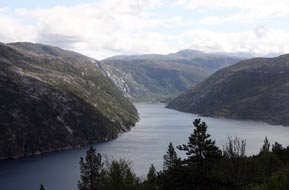 the air with fine, soaking drizzle, we drove back through
the deserted main street and along the E6 to find Narvik Camping. In this
miserably grim weather with the rain churning the campsite driveway into slurry,
we found a pitch on the uppermost of the 3 camping areas terraced up the steep
hillside overlooking the fjord which was scarcely visible with the cloud cover
down to valley bottom (see right). We could just about make out the railway line on the
opposite hillside with ore trains passing regularly. So far this trip we had not
enjoyed one sighting of the Midnight sun, and in this wretchedly chill weather
we were certainly not going to see it tonight. the air with fine, soaking drizzle, we drove back through
the deserted main street and along the E6 to find Narvik Camping. In this
miserably grim weather with the rain churning the campsite driveway into slurry,
we found a pitch on the uppermost of the 3 camping areas terraced up the steep
hillside overlooking the fjord which was scarcely visible with the cloud cover
down to valley bottom (see right). We could just about make out the railway line on the
opposite hillside with ore trains passing regularly. So far this trip we had not
enjoyed one sighting of the Midnight sun, and in this wretchedly chill weather
we were certainly not going to see it tonight.
A ride on the Ofotbanen railway into the
mountains of the Swedish border: gloomy cloud still clung tenaciously
to the mountains the following morning but was beginning to break. Our plan for
today, the only time for which any sun was forecast for the next week, was to
catch the morning Narvik~Luleå train back up into the mountains to Riksgränsen
just across the Swedish border to experience the Malmbanan/Ofotbanen railway
line, before returning to Narvik on the lunchtime train to complete our visits
in Narvik this afternoon. Promptly at 10-15am the train pulled out for our 50
minute journey and was soon gaining height along a rocky shelf high above Ofotfjord
(Photo 1 - Fjord views from train on the Ofotbanan railway) with the E6 way
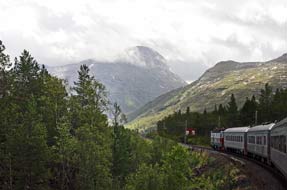 below us along the loch-shore and the Rombaksbrua
suspension bridge crossed yesterday soon coming into view through the line-side
trees. The line continued impressively high above Rombaksbotn with the raw,
craggy mountain face opposite streaked with watercourses tumbling down the
near-vertical mountainside (Photo 2 - Ofotsbanan railway curving through mountainous scenery).
After a pause at an isolated station-halt, the train moved off again into
magnificently desolate mountain scenery, and we stood taking photos of these
glorious surroundings from the train windows or from the rear lobby looking back
down the line; our admiration for the builders of this
spectacular line increased a hundredfold. The line passed through short tunnels
and snow-sheds
(Photo 3 - Snow-sheds on the Ofotbanan railway) and just beyond Katterat
a longer tunnel built in 2002 when the original line was rerouted to bypass the
now disused Norddal trestle-viaduct
(Photo 4 - Disused Norddal trestle-viaduct). In 1940
the below us along the loch-shore and the Rombaksbrua
suspension bridge crossed yesterday soon coming into view through the line-side
trees. The line continued impressively high above Rombaksbotn with the raw,
craggy mountain face opposite streaked with watercourses tumbling down the
near-vertical mountainside (Photo 2 - Ofotsbanan railway curving through mountainous scenery).
After a pause at an isolated station-halt, the train moved off again into
magnificently desolate mountain scenery, and we stood taking photos of these
glorious surroundings from the train windows or from the rear lobby looking back
down the line; our admiration for the builders of this
spectacular line increased a hundredfold. The line passed through short tunnels
and snow-sheds
(Photo 3 - Snow-sheds on the Ofotbanan railway) and just beyond Katterat
a longer tunnel built in 2002 when the original line was rerouted to bypass the
now disused Norddal trestle-viaduct
(Photo 4 - Disused Norddal trestle-viaduct). In 1940
the
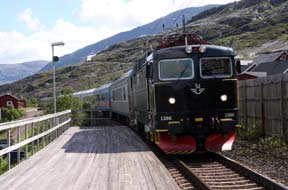 Norwegians had attempted to blow this up to prevent Swedish iron ore
supplies reaching the Germans, but the demolition failed; the Germans soon
repaired the damage to re-open the line for ore traffic. Just after Björnfjall,
the highest station, the train crossed the Swedish border and halted at Riksgränsen
where we got off, the 'station' being little more than a platform partly under a
snow-shed (see left). Norwegians had attempted to blow this up to prevent Swedish iron ore
supplies reaching the Germans, but the demolition failed; the Germans soon
repaired the damage to re-open the line for ore traffic. Just after Björnfjall,
the highest station, the train crossed the Swedish border and halted at Riksgränsen
where we got off, the 'station' being little more than a platform partly under a
snow-shed (see left).
The ski-resort of Riksgränsen spreads across the
plateau below the railway line
(Photo 5 - Riksgränsen Ski-resort and fell-land plateau), totally different terrain from the tiers of
mountain peaks which characterised the Norwegian side of the border on the 40km
steep descent to the fjord-indented coastline. As we stood admiring this
panorama of fell-land plateau, 2 LKAB ore trains trundled through in quick
succession
(Photo 6 - LKAB iron ore train passing through Riksgränsen). There was little to do at the ski-resort, ghostly and empty at this
time of year, and we sat at the veranda of a deserted hotel to eat our lunch
before returning up to the station for our return train, the overnight sleeper
from Stockholm. The return journey was just as thrilling passing through such
impressive mountainous terrain which again showed the heroic scale of the line's
1902 construction. At 1-30pm the train pulled into Narvik station after what was
surely one of the most thrilling rail journey of our travels.
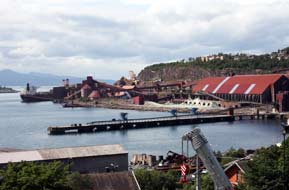 An afternoon of exploration at Narvik: the Narvik-Nord Museum,
housed in the former HQ of the Ofotbanen railway, documents Narvik's fishing
and farming, railway building and ore transhipment heritage. Built on a high
promontory overlooking Narvik harbour, the house's terrace gave a perfect view
in the afternoon sunshine across to the LKAB ore terminal on the opposite side
of the fjord (Photo
7 - LKAB iron ore terminal at Narvik harbour). The
museum curator welcomed us and suggested we first watch the English-language
version of their film describing Narvik's origins as a fishing-farming village
to its 1902 foundation as LKAB's ore terminal port. The town developed rapidly
with the mining company as its main employer and its year-round ice-free harbour
serving as the main shipping outlet for iron ore transported from the mines at
Gällivare and Kiruna. The archive film and computer graphics showed Narvik as a
model town of fine wooden buildings clustered around the harbour. But all that
came to a dramatically destructive end on 9 April 1940 with the German invasion:
over the next 2 months, the town was fought over, shelled from naval vessels and
heavily bombed by the Luftwaffe, leaving the little port in ruins. Most of the
town's pre-war wooden buildings were destroyed and after liberation in 1945,
Narvik was rebuilt as we see it today. The museum displays showed the
construction of the Ofotbanen railway, ore terminal and loading of ore
carrier-ships, and the post-war salvage of wrecks sunk in the harbour. In a
corner room overlooking the modern harbour, a telescope was set up for visitors
to examine the modern-day LKAB ore terminal and bulk ore ships moored in the
harbour (see right). An afternoon of exploration at Narvik: the Narvik-Nord Museum,
housed in the former HQ of the Ofotbanen railway, documents Narvik's fishing
and farming, railway building and ore transhipment heritage. Built on a high
promontory overlooking Narvik harbour, the house's terrace gave a perfect view
in the afternoon sunshine across to the LKAB ore terminal on the opposite side
of the fjord (Photo
7 - LKAB iron ore terminal at Narvik harbour). The
museum curator welcomed us and suggested we first watch the English-language
version of their film describing Narvik's origins as a fishing-farming village
to its 1902 foundation as LKAB's ore terminal port. The town developed rapidly
with the mining company as its main employer and its year-round ice-free harbour
serving as the main shipping outlet for iron ore transported from the mines at
Gällivare and Kiruna. The archive film and computer graphics showed Narvik as a
model town of fine wooden buildings clustered around the harbour. But all that
came to a dramatically destructive end on 9 April 1940 with the German invasion:
over the next 2 months, the town was fought over, shelled from naval vessels and
heavily bombed by the Luftwaffe, leaving the little port in ruins. Most of the
town's pre-war wooden buildings were destroyed and after liberation in 1945,
Narvik was rebuilt as we see it today. The museum displays showed the
construction of the Ofotbanen railway, ore terminal and loading of ore
carrier-ships, and the post-war salvage of wrecks sunk in the harbour. In a
corner room overlooking the modern harbour, a telescope was set up for visitors
to examine the modern-day LKAB ore terminal and bulk ore ships moored in the
harbour (see right).
Narvik iron ore terminal: unfortunately we should not be in Narvik
on a Tuesday when LKAB offers tours of the ore terminal but the museum curator
suggested places in the town from where we could see Narvik's main raison d'être
where Sweden's iron mining output is loaded for maritime export. From the
museum,
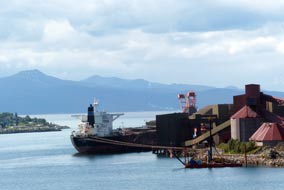 we turned off across a new section of road winding over to a new
shopping complex built on reclaimed industrial land amid the ore tips and
sidings of the LKAB terminal area. Above towered the tall brick stanchions of a
former ore delivery system, now partially demolished and replaced in 2009 by the
latest underground silo system. LKAB opened its ore loading terminal at Narvik
harbour in 1903, just 2 years before Norway seceded from union with the Swedish
kingdom. Narvik was chosen as the export port for ore, the harbour being ice-free
all year round and deep enough for large ocean-going bulk ore-carrying ships of
up to 350,000 tons; nowadays 75% of LKAB's total ore production is shipped from
Narvik (see left). Every day 60,000 tons of ore are transported by trains of hopper wagons
each containing 100 tons of ore pellets and hauled by the world's most powerful
electric locos. The new underground silo system at Narvik was blasted out of
solid rock, with each of the 12 silos, 38m in diameter, 60m deep, storing
110,000 tons of ore products (16 train loads). Lines of hopper-wagons are backed
over the silos in a covered tunnel and ore unloaded by remote control, dropping
their contents while the train moves slowly over the silos, each wagon taking
just 5 seconds to deposit its load into the silo. When a ship is ready for
loading, conveyors transport the ore from the silo base into the ship's
containers at the port's 5 ship-loading quays (Photo
8 - Bulk iron ore ship being loaded at Narvik LKAB terminal). The silo-system is claimed
by LKAB environmentally to produce less dust and noise pollution over the town,
and 19 million tons of ore are shipped annually from Narvik, the port handling
around 200 ship-loadings each year to world-wide export destinations. we turned off across a new section of road winding over to a new
shopping complex built on reclaimed industrial land amid the ore tips and
sidings of the LKAB terminal area. Above towered the tall brick stanchions of a
former ore delivery system, now partially demolished and replaced in 2009 by the
latest underground silo system. LKAB opened its ore loading terminal at Narvik
harbour in 1903, just 2 years before Norway seceded from union with the Swedish
kingdom. Narvik was chosen as the export port for ore, the harbour being ice-free
all year round and deep enough for large ocean-going bulk ore-carrying ships of
up to 350,000 tons; nowadays 75% of LKAB's total ore production is shipped from
Narvik (see left). Every day 60,000 tons of ore are transported by trains of hopper wagons
each containing 100 tons of ore pellets and hauled by the world's most powerful
electric locos. The new underground silo system at Narvik was blasted out of
solid rock, with each of the 12 silos, 38m in diameter, 60m deep, storing
110,000 tons of ore products (16 train loads). Lines of hopper-wagons are backed
over the silos in a covered tunnel and ore unloaded by remote control, dropping
their contents while the train moves slowly over the silos, each wagon taking
just 5 seconds to deposit its load into the silo. When a ship is ready for
loading, conveyors transport the ore from the silo base into the ship's
containers at the port's 5 ship-loading quays (Photo
8 - Bulk iron ore ship being loaded at Narvik LKAB terminal). The silo-system is claimed
by LKAB environmentally to produce less dust and noise pollution over the town,
and 19 million tons of ore are shipped annually from Narvik, the port handling
around 200 ship-loadings each year to world-wide export destinations.
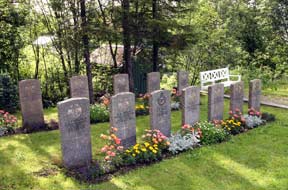 Narvik's war cemetery: before
returning for our second night at Narvik Camping, we paused at the town's large
civic cemetery to find the war graves from the 1940 battles for control of
Narvik. In one corner were the graves and memorial to the French troops killed
in the fighting and on the far side the stark Teutonic crosses of the German war
graves. Tucked away in a remote corner we found the Commonwealth War Graves
Commission cemetery of British soldiers, sailors and airman killed at Narvik
(see right) (Photo
9 - CWGC war cemetery at Narvik),
and next to this a memorial to the Polish war dead; we stood awhile
silently paying our respects, as yet another LKAB iron ore train trundled past
across the hillside on its way to the port. Narvik's war cemetery: before
returning for our second night at Narvik Camping, we paused at the town's large
civic cemetery to find the war graves from the 1940 battles for control of
Narvik. In one corner were the graves and memorial to the French troops killed
in the fighting and on the far side the stark Teutonic crosses of the German war
graves. Tucked away in a remote corner we found the Commonwealth War Graves
Commission cemetery of British soldiers, sailors and airman killed at Narvik
(see right) (Photo
9 - CWGC war cemetery at Narvik),
and next to this a memorial to the Polish war dead; we stood awhile
silently paying our respects, as yet another LKAB iron ore train trundled past
across the hillside on its way to the port.
Northwards to Tromsø: the forecast rain began overnight, and this
morning low, cloying cloud again hung from the mountains. We had a long day of
driving ahead of us, but first we needed to return to Narvik to find a tyre
repair garage to deal with a slow puncture in a nail-pierced tyre. In a side street
opposite the station, we found a repair workshop for the damaged dekk,
the Norwegian word we had learnt for tyre. "So you want it fixing", the jovial man
responded; "no problem, 30 seconds", and he pulled an inch long nail from tyre and
plugged the hole with a stick of rubber compound; he re-inflated the tyre and
the job was done before you could say gummi-dekk. After our 48 hour stay,
we had come to know and to like the friendly little port-town of Narvik, and we
finally left to drive north taking with us happy memories of a satisfyingly
learning packed visit.
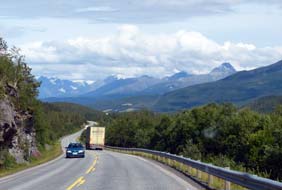 Heading along the E6, back across the Rombaks
bridge and the north shore of Ofotfjord, we continued north at Bjerkvik where
the E10 turned westwards towards the Lofoten Islands, sowing the seeds of next
year's possible travels to these northern lands. The E6 road began a long, winding
and steep climb up into the mountains to the tree line, and from the high point
descended a similar distance to Storfossen and along a mountain valley towards
Fossbakken (see left), passing a number of the 1940 battle sites where the lightly armed
Norwegian forces had harried the Germans as they had advanced northwards into
the mountainous interior. Defending their homeland against German invaders, the
Norwegians led by General Carl Gustav Fleischer had achieved commendable success
in halting the German advance at Lapphaugen, the first major Allied victory
against German land forces (Photo 10 - Memorial to Norwegian 1940 victory at Lapphaugen).
Here we paused at the memorial commemorating Norwegian successes against
superior German Heading along the E6, back across the Rombaks
bridge and the north shore of Ofotfjord, we continued north at Bjerkvik where
the E10 turned westwards towards the Lofoten Islands, sowing the seeds of next
year's possible travels to these northern lands. The E6 road began a long, winding
and steep climb up into the mountains to the tree line, and from the high point
descended a similar distance to Storfossen and along a mountain valley towards
Fossbakken (see left), passing a number of the 1940 battle sites where the lightly armed
Norwegian forces had harried the Germans as they had advanced northwards into
the mountainous interior. Defending their homeland against German invaders, the
Norwegians led by General Carl Gustav Fleischer had achieved commendable success
in halting the German advance at Lapphaugen, the first major Allied victory
against German land forces (Photo 10 - Memorial to Norwegian 1940 victory at Lapphaugen).
Here we paused at the memorial commemorating Norwegian successes against
superior German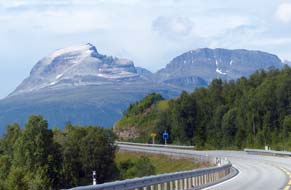 firepower. The success was short-lived since the Norwegian King
and government scuttled off to England virtually abandoning their brave forces,
capitulating to the Germans and handing power to the lackey Quisling. Fleischer
was compelled also to flee to England and later committed suicide after being
passed over for command of the Norwegian forces. firepower. The success was short-lived since the Norwegian King
and government scuttled off to England virtually abandoning their brave forces,
capitulating to the Germans and handing power to the lackey Quisling. Fleischer
was compelled also to flee to England and later committed suicide after being
passed over for command of the Norwegian forces.
Continuing northwards on the E6 into the bleak,
mountain-surrounded Salangsdalen, we passed through several small townships
before rising again over wild mountainous country and descending around the
shores of Balsfjorden, the innermost reaches of Tromsø Fjord, with sun breaking
through the thinning cloud giving the fjord a markedly blue sheen. At the fjord-botn,
the
E6 reached the village of Nordkjosbotn merging with E8 coming in from the right
from Skibotn and Kilpisjärvi (familiar territory for us from last year's
travels). We took the signposted turning left northward for Tromsø along the
fjord's northern shore, pausing to photograph the magnificent array of
snow-capped peaks surrounding the blue waters of the fjord (Photo 11 - Balsfjord backed by snow-flecked peaks). Ahead the shapely
carved peak of Svartnestinden held our attention (see right) as we turned across a northern
extension of this craggy ridge and down to the L-shaped inlet of Ramsfjorden
where by chance at Sørbotn we spotted a well-placed little campsite at
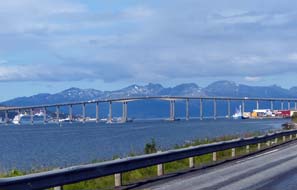 the head of the
loch. The road continued along the shore of the main Tromsø Fjord and ahead in
the distance, as we drew closer, the city of Tromsø grew in size over on its
island with the high arching bridge spanning the straits (see left). Along the waterfront
cruise ships were moored including one of the Hurtigruten coastal liners,
(literally 'Express Journey') which for more than a century have provided an
essential year-round delivery lifeline of freight, essential supplies, mail
and passengers, linking all the isolated Norwegian coastal communities at which
the liners call between Bergen and Kirkenes. the head of the
loch. The road continued along the shore of the main Tromsø Fjord and ahead in
the distance, as we drew closer, the city of Tromsø grew in size over on its
island with the high arching bridge spanning the straits (see left). Along the waterfront
cruise ships were moored including one of the Hurtigruten coastal liners,
(literally 'Express Journey') which for more than a century have provided an
essential year-round delivery lifeline of freight, essential supplies, mail
and passengers, linking all the isolated Norwegian coastal communities at which
the liners call between Bergen and Kirkenes.
Tromsø Camping, the trip's worst campsite and a
place to avoid: Beyond the bridge, we headed for tonight's campsite, Tromsø
Camping. We knew this would be monopolistically expensive and had no great
expectations, but even so we were appalled at the unprecedented depths which this
dreadful place plumbed: inhospitable and rule-book bound attitudes from the
indifferent staff at reception, a filthy, waterlogged and overcrowded camping
area, grubby and wholly inadequate facilities, and worst of all horrendously
over-inflated prices (305 NOK/night) made the place an utter disgrace to the
city of Tromsø. Be warned. Late in the afternoon after
a long and wearying drive, today we had no option but to stay but just for one night
and, trying to remain indifferent to the squalidly fetid surroundings, settled
in condemning this as the trip's very worst campsite. Ramfjord Camping just
25kms south is an immeasurably better alternative for visiting Tromsø (see
later).
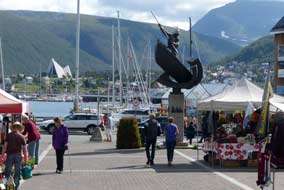 A visit to Tromsø: the following
morning, with the sun just breaking through, we left the camper parked at the
campsite and caught the #20/24 bus into the city centre. Now the largest city in
Northern Norway with a population of 63,000, Tromsø had begun life as a fishing
village with sea-farers using its sheltered, ice-free harbour. Growing as a
trading station, the town received its municipal charter in 1794 and during the
19th century flourished as the base for regular Arctic hunting expeditions for
Arctic fox, polar bears, reindeer and walrus on Svalbard but most particularly
the rich rewards of hunting seals for their skins and blubber. In the late
19th/early 20th centuries, Tromsø gained national attention as the starting
point for a series of much-publicised polar expeditions by Roald Amundsen and
Fridtjof Nansen. Amundsen flew from here in 1928 on his fatal mission searching
for the missing Italian airship explorer Nobile as we had learnt at Vadsø last
year. The modern city now has a range of industries and the world's northernmost
university and is spread across the island of Tromsøya set snugly in its
sheltered sound between the mountainous mainland and the larger offshore island
of Kvaløya, and connected to the mainland by its elegantly slender high-arching
bridge (Photo 12 - Bridge over straits at Tromsø harbour). Our bus, with bargain reduced prices for seniors, crossed the bridge and
dropped us at Stortorget by the small harbour-side market; by now the surrounding
circle of mountains were lit by bright morning sunshine (Photo 13 - Harbour-side market and fishermen's memorial at Tromsø). A visit to Tromsø: the following
morning, with the sun just breaking through, we left the camper parked at the
campsite and caught the #20/24 bus into the city centre. Now the largest city in
Northern Norway with a population of 63,000, Tromsø had begun life as a fishing
village with sea-farers using its sheltered, ice-free harbour. Growing as a
trading station, the town received its municipal charter in 1794 and during the
19th century flourished as the base for regular Arctic hunting expeditions for
Arctic fox, polar bears, reindeer and walrus on Svalbard but most particularly
the rich rewards of hunting seals for their skins and blubber. In the late
19th/early 20th centuries, Tromsø gained national attention as the starting
point for a series of much-publicised polar expeditions by Roald Amundsen and
Fridtjof Nansen. Amundsen flew from here in 1928 on his fatal mission searching
for the missing Italian airship explorer Nobile as we had learnt at Vadsø last
year. The modern city now has a range of industries and the world's northernmost
university and is spread across the island of Tromsøya set snugly in its
sheltered sound between the mountainous mainland and the larger offshore island
of Kvaløya, and connected to the mainland by its elegantly slender high-arching
bridge (Photo 12 - Bridge over straits at Tromsø harbour). Our bus, with bargain reduced prices for seniors, crossed the bridge and
dropped us at Stortorget by the small harbour-side market; by now the surrounding
circle of mountains were lit by bright morning sunshine (Photo 13 - Harbour-side market and fishermen's memorial at Tromsø).
Tromsø Polar Museum: after a glance
around the market stalls, we ambled along the waterfront, past ship repair yards
with small vessels drawn up on slipways, to find the Tromsø Polar Museum housed
in a wooden 19th century customs warehouse and operated by the University of
Tromsø (Photo 14 - Tromsø Polar Museum). What appeared from the outside as a small museum turned out to be an
amazingly expansive Tardis of a place, opened in 1978 on the 50th anniversary of
Amundsen's departure from Tromsø on his final fatal expedition, and documenting
both the history of
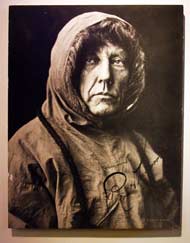 Arctic hunting and sealing around Svalbard and detailed
accounts of Amundsen's and Nansen's polar explorations. And as a bonus, they
offered a half-price seniors' combined ticket for both the museum and conserved
sealing ship M/S Polstjerna. The ground floor showed impressively
well-presented displays describing Arctic seal hunting and over-wintering in
Svalbard, and the 1594 discovery of Svalbard by the Dutch explorer Willem
Barents on his voyage to discover the NE Passage connecting the Arctic and
Pacific Oceans as a trading route to China; the displays included a crude sketch
map of the Arctic hunting and sealing around Svalbard and detailed
accounts of Amundsen's and Nansen's polar explorations. And as a bonus, they
offered a half-price seniors' combined ticket for both the museum and conserved
sealing ship M/S Polstjerna. The ground floor showed impressively
well-presented displays describing Arctic seal hunting and over-wintering in
Svalbard, and the 1594 discovery of Svalbard by the Dutch explorer Willem
Barents on his voyage to discover the NE Passage connecting the Arctic and
Pacific Oceans as a trading route to China; the displays included a crude sketch
map of the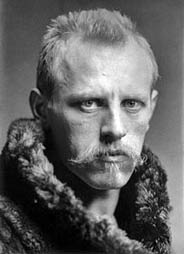 Arctic made by Barents showing the position of Svalbard as Het Nieuwe
Land (The New Land). The upper story displays admirably charted the
remarkable polar expeditions of the Norwegian explorer Roald Amundsen
(1872~1928) (see left): the 1903~06 endurance stretching expedition in the converted
sealer-ship Gjøa to discover the NW Passage through Northern Canada to
Alaska and the Pacific; the 1910~12 Antarctic expedition when he became the
first to reach the South Pole famously beating his British rival Captain Robert
Scott who perished on his return trek across the ice continent; in 1925~26 he
turned to using aircraft and airships in an attempt to reach the North Pole, and
was finally killed when the aircraft he was using to search for Noble in 1928
crashed on the polar ice. The superb series of photographs and memorabilia
showed the thoroughness of his expeditions' organisation and the hardships
endured. Amundsen clearly was at home in front of the camera as the photographs
of this famous Norwegian with his distinctive hooked nose and bushy eyebrows
showed. The final displays documented the life of the Norwegian explorer and
diplomat Fridtjof Nansen (1861~1930) (see right), who in 1895 made an abortive attempt to
reach the North Pole by dog-sledge after his strengthened ship became trapped in
the polar ice. He failed to reach the Pole and, after 15 months of
over-wintering endurance, finally returned to Svalbard. After WW1 he became a
diplomat and leading figure in humanitarian relief through the League of
Nations, aiding resettlement of Greeks and Turks in the tragic 1921 population
exchanges. He was awarded the Nobel Peace Prize in 1922, giving the money to
international relief efforts, and died quietly in Oslo in 1930. The
Tromsø Polar Museum, so unassuming from first impressions, is an amazingly informative
collection and well worth a visit. Arctic made by Barents showing the position of Svalbard as Het Nieuwe
Land (The New Land). The upper story displays admirably charted the
remarkable polar expeditions of the Norwegian explorer Roald Amundsen
(1872~1928) (see left): the 1903~06 endurance stretching expedition in the converted
sealer-ship Gjøa to discover the NW Passage through Northern Canada to
Alaska and the Pacific; the 1910~12 Antarctic expedition when he became the
first to reach the South Pole famously beating his British rival Captain Robert
Scott who perished on his return trek across the ice continent; in 1925~26 he
turned to using aircraft and airships in an attempt to reach the North Pole, and
was finally killed when the aircraft he was using to search for Noble in 1928
crashed on the polar ice. The superb series of photographs and memorabilia
showed the thoroughness of his expeditions' organisation and the hardships
endured. Amundsen clearly was at home in front of the camera as the photographs
of this famous Norwegian with his distinctive hooked nose and bushy eyebrows
showed. The final displays documented the life of the Norwegian explorer and
diplomat Fridtjof Nansen (1861~1930) (see right), who in 1895 made an abortive attempt to
reach the North Pole by dog-sledge after his strengthened ship became trapped in
the polar ice. He failed to reach the Pole and, after 15 months of
over-wintering endurance, finally returned to Svalbard. After WW1 he became a
diplomat and leading figure in humanitarian relief through the League of
Nations, aiding resettlement of Greeks and Turks in the tragic 1921 population
exchanges. He was awarded the Nobel Peace Prize in 1922, giving the money to
international relief efforts, and died quietly in Oslo in 1930. The
Tromsø Polar Museum, so unassuming from first impressions, is an amazingly informative
collection and well worth a visit.
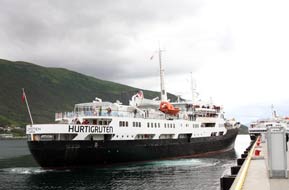 The Hurtigruten docking at Tromsø Harbour:
after calling in at the imposing mitre-shaped city library to use their free
internet to consult the weather forecast (NB wherever you are world-wide, be
sure to use the web site of Norwegian Meteorological Institute -
select English from pull-down menu and enter your location; from our experience
this site, used by Norwegian shipping, provides the most reliably accurate
weather forecasts), we hurried down to the docks since it was approaching
2-30pm, the time of the north-bound Hurtigruten's The Hurtigruten docking at Tromsø Harbour:
after calling in at the imposing mitre-shaped city library to use their free
internet to consult the weather forecast (NB wherever you are world-wide, be
sure to use the web site of Norwegian Meteorological Institute -
select English from pull-down menu and enter your location; from our experience
this site, used by Norwegian shipping, provides the most reliably accurate
weather forecasts), we hurried down to the docks since it was approaching
2-30pm, the time of the north-bound Hurtigruten's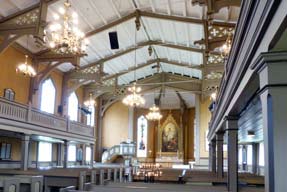 arrival. Our old friend the
M/S Lofoten, which we had seen last year at Kjøllefjord (see our 2012 log),
pulled in quietly and moored at the quayside (see left); passengers
disembarked to join the waiting tour-buses and the ship's crane busily began
unloading pallets of toilet rolls, bottles of Coke and other such essentials of
daily living (Photo 15 - North-bound Hurtigruten M/S Lofoten unloading at Tromsø). arrival. Our old friend the
M/S Lofoten, which we had seen last year at Kjøllefjord (see our 2012 log),
pulled in quietly and moored at the quayside (see left); passengers
disembarked to join the waiting tour-buses and the ship's crane busily began
unloading pallets of toilet rolls, bottles of Coke and other such essentials of
daily living (Photo 15 - North-bound Hurtigruten M/S Lofoten unloading at Tromsø).
Tromsø Cathedral: just up the street
from the harbour we reached Tromsø Lutheran Domkirke, one of Norway's largest
wooden churches and the episcopal church of the northern provinces of Troms and
Finmark. Built in 1861 in Neo-Gothic style, its scale showed the prosperity of
the city's 19th century merchants who grew rich from trading with Russia and
part-funded the cathedral. The interior was well-lit with its angular pointed
Gothic windows and high ceiling and we spent a while taking our photos (Photo 16 - Neo-Gothic interior of Tromsø Cathedral). The
streets around the cathedral square were graced with elegant wooden buildings
which has survived a city fire of the early 1990s.
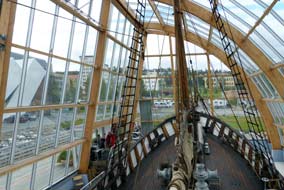 The preserved sealing ship M/S
Polstjerna: from here we walked along Strandtorget, past
warehouses and local ferries along the waterfront to find the preserved sealing
ship M/S Polstjerna (Pole Star). Built in 1949, she sailed for 38
hunting seasons to the Arctic Ocean around Svalbard bringing back an incredible 97,000 seals.
The vessel also took part in Arctic polar exploration, and since 2003 is now
conserved within a specially constructed glass house as a monument to Tromsø's
history of Arctic seal hunting (see left), and we spent the next hour clambering around
inside and underneath the vessel learning more about the gruesome business of
hunting seals (Photo 17 - Preserved sealing ship M/S Polstjerna). The preserved sealing ship M/S
Polstjerna: from here we walked along Strandtorget, past
warehouses and local ferries along the waterfront to find the preserved sealing
ship M/S Polstjerna (Pole Star). Built in 1949, she sailed for 38
hunting seasons to the Arctic Ocean around Svalbard bringing back an incredible 97,000 seals.
The vessel also took part in Arctic polar exploration, and since 2003 is now
conserved within a specially constructed glass house as a monument to Tromsø's
history of Arctic seal hunting (see left), and we spent the next hour clambering around
inside and underneath the vessel learning more about the gruesome business of
hunting seals (Photo 17 - Preserved sealing ship M/S Polstjerna).
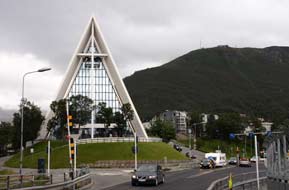 Tromsø's Ishavskatedralen (Arctic Cathedral):
it was by now 4-30pm and we had a long walk back through the town and over the
bridge for the views along the sound, despite the now heavy cloud and
increasingly poor light. But we just had time to call in at a harbour-side pub
to sample the local Macks beer brewed in Tromsø since we were not prepared to
pay an excessive 160 NOKs for a brewery visit. Back along through the town, we
followed the road around onto the bridge which arched up steeply to its high
point to allow clearance for large ships to dock at Tromsø's port. The bridge's
apex gave the perfect vantage point for photos across to the city against the
mountainous backdrop down the length of the sound (Photo 18 - View over Tromsø harbour from bridge). Unfortunately the
bright sun of earlier had now been supplanted by dark and gloomily overcast
conditions with misty rain looming along the sound from the north. Over the brow
of the bridge, the spectacular modernistic church of Ishavskatedralen (Arctic
Cathedral) came into view (see right). Built in 1965, the parish church (not in fact of
cathedral status) is made up of 11 triangular concrete segments, the east end
formed by an immense stained-glass window. Tromsø's Ishavskatedralen (Arctic Cathedral):
it was by now 4-30pm and we had a long walk back through the town and over the
bridge for the views along the sound, despite the now heavy cloud and
increasingly poor light. But we just had time to call in at a harbour-side pub
to sample the local Macks beer brewed in Tromsø since we were not prepared to
pay an excessive 160 NOKs for a brewery visit. Back along through the town, we
followed the road around onto the bridge which arched up steeply to its high
point to allow clearance for large ships to dock at Tromsø's port. The bridge's
apex gave the perfect vantage point for photos across to the city against the
mountainous backdrop down the length of the sound (Photo 18 - View over Tromsø harbour from bridge). Unfortunately the
bright sun of earlier had now been supplanted by dark and gloomily overcast
conditions with misty rain looming along the sound from the north. Over the brow
of the bridge, the spectacular modernistic church of Ishavskatedralen (Arctic
Cathedral) came into view (see right). Built in 1965, the parish church (not in fact of
cathedral status) is made up of 11 triangular concrete segments, the east end
formed by an immense stained-glass window.
Ramfjord Camping, the perfect campsite for
visiting Tromsø: back at Tromsø Camping, we collected our camper and,
unable to face or afford a second night at this disgusting campsite and thankful
to be leaving, we set off late in the afternoon to drive back along the sound.
By good fortune we had on the drive north spotted a small campsite at the innermost recess of Ramfjorden. Before leaving Tromsø, we had telephoned and
received a welcoming greeting; it was with a glad heart we now turned into the
small Ramfjord Camping 5kms south of Fagernes. The welcome we received
from the fluently English-speaking owner was the total antithesis of the grim
experience last evening at Tromsø Camping, warmly friendly, hospitable and
helpful; the setting was truly spectacular looking down the length of Ramfjorden
and surrounded by towering mountains; if such an excellent and welcoming
campsite as
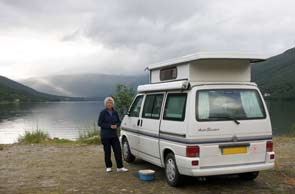 Ramfjord Camping in such a wonderful setting can charge just 210 NOK/night,
what conceivable justification could an inhospitable and filthy dump like Tromsø
Camping have for charging an outrageous 305 NOK other than sheer unadulterated
greed; the sooner this exploitational monopoly is forced out of business, the
better. Contribute to the cause and boycott this abominable campsite. Ramfjord Camping in such a wonderful setting can charge just 210 NOK/night,
what conceivable justification could an inhospitable and filthy dump like Tromsø
Camping have for charging an outrageous 305 NOK other than sheer unadulterated
greed; the sooner this exploitational monopoly is forced out of business, the
better. Contribute to the cause and boycott this abominable campsite.
Despite it being a gloomily dull evening, we
happily settled in at Ramfjord Camping to enjoy supper and the magnificent view
looking down the fjord, happy to have found such an agreeable alternative base
for visiting Tromsø. Regrettably there would be no Midnight Sun tonight, but on a
fine evening with such a wonderfully open westward-facing mountainous setting
(see left),
this would be the perfect spot for a full appreciation of the Midnight Sun (Photo 19 - Ramfjord Camping looking down length of fjord). It
had been another engaging day and we had learnt much in the friendly city of Tromsø,
but one day was insufficient for all there is to see. We had learnt from
Ramfjord Camping's helpful owner the exact location in Tromsø Fjord where the
Tirpitz had finally been sunk by RAF Lancasters in November 1944. So to
complete our Tirpitz appreciation after last year's visit to Kåfjord and
this year's find of Easy Elsie's crash-landing site, there is no question
but we shall have to make a return visit to Tromsø next year, and there is no
question also but we shall stay again at Ramfjord Camping, Sørbotn.
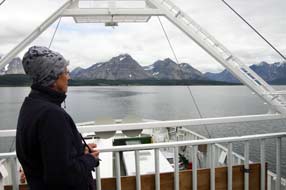 Across Lyngenfjord to Olderdalen:
we had a relaxed morning camped by Ramfjord, intending today to catch the 13-25 Breivikeidet ferry across Ullsfjord to Svensby
then from the far side of the Lyngsfjell peninsula to cross the Lyngen Fjord by ferry from Lyngseidet
to Olderdalen and pick up the E6 south to camp at Skibotn tonight. Unfortunately
the weather was still overcast with cloud clinging to the surrounding mountains
as we took Route 91 from Fagernes along the narrow Storelva and Breivikelva
valley between 2 high mountain masses, and joined other vehicles queuing at the
Breivikeidet ferry dock for the Ullsfjorden crossing.
Low cloud still partly obscured the serrated, glacier-strewn line of peaks of
the Lyngen Alps gracing the skyline on the far side of the fjord as we watched
the ferry approaching the Breivikeidet landing stage (Photo 20 - Ferry approaching Breivikeidet against backdrop of Lyngen Alps). Boarding the
ferry, we were
pleasantly surprised that, with George's trim size, he qualified for the same
fare as a car, a very reasonable 130 NOK (around £14). From up on the high open
deck space for the 20 minute crossing, we watched the Lyngen Alps getting closer
as we neared Svensby (see right and below). Once
ashore we pulled over to allow other disembarking vehicles including large
trucks to pass then turned northwards along the side lane to find the former
farm-stead now conserved as a museum. The turf-roofed cottage and farm buildings
nestled on a Across Lyngenfjord to Olderdalen:
we had a relaxed morning camped by Ramfjord, intending today to catch the 13-25 Breivikeidet ferry across Ullsfjord to Svensby
then from the far side of the Lyngsfjell peninsula to cross the Lyngen Fjord by ferry from Lyngseidet
to Olderdalen and pick up the E6 south to camp at Skibotn tonight. Unfortunately
the weather was still overcast with cloud clinging to the surrounding mountains
as we took Route 91 from Fagernes along the narrow Storelva and Breivikelva
valley between 2 high mountain masses, and joined other vehicles queuing at the
Breivikeidet ferry dock for the Ullsfjorden crossing.
Low cloud still partly obscured the serrated, glacier-strewn line of peaks of
the Lyngen Alps gracing the skyline on the far side of the fjord as we watched
the ferry approaching the Breivikeidet landing stage (Photo 20 - Ferry approaching Breivikeidet against backdrop of Lyngen Alps). Boarding the
ferry, we were
pleasantly surprised that, with George's trim size, he qualified for the same
fare as a car, a very reasonable 130 NOK (around £14). From up on the high open
deck space for the 20 minute crossing, we watched the Lyngen Alps getting closer
as we neared Svensby (see right and below). Once
ashore we pulled over to allow other disembarking vehicles including large
trucks to pass then turned northwards along the side lane to find the former
farm-stead now conserved as a museum. The turf-roofed cottage and farm buildings
nestled on a
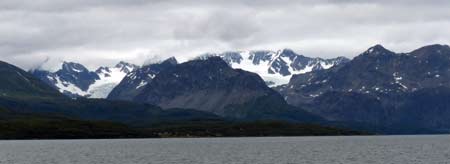 narrow strip of fjord-side land where a hard living had been
scraped from farming and fishing. Back to Svensby, we continued eastwards along
the narrow Kjosen side-inlet which formed the one gap for the road across the
20km width of the Lyngen peninsula. Just a 3km isthmus of higher land at the
eastern end of the narrow valley prevented Ullsfjord and Storfjord from linking
up and separating the Lyngen peninsula into a full island. Along this narrow
valley and over the high isthmus at the far end, we dropped down to the ferry
dock at the large settlement of Lyngseidet and drove aboard the waiting ferry.
The fare for the longer 30 minute crossing of Lyngen Fjord was 177 NOK, but as
the ferry crossed the wide Lyngenfjord the views looking back along the length
of the snow-covered alpine ridge were spectacular (Photo 21 - Ferry crossing Lyngenfjord against backdrop of Lyngen Alps).
With
the chill wind whipping up rougher waters as the ferry crossed the wide mouth of Kåfjord
to approach Olderdalen, we could look down the murky length of this side fjord enclosed by
mighty mountains which today seemed so forbiddingly gloomy in dark cloud (Photo
22 - Mountain-enclosed Kåfjord from ferry approaching Olderdalen). narrow strip of fjord-side land where a hard living had been
scraped from farming and fishing. Back to Svensby, we continued eastwards along
the narrow Kjosen side-inlet which formed the one gap for the road across the
20km width of the Lyngen peninsula. Just a 3km isthmus of higher land at the
eastern end of the narrow valley prevented Ullsfjord and Storfjord from linking
up and separating the Lyngen peninsula into a full island. Along this narrow
valley and over the high isthmus at the far end, we dropped down to the ferry
dock at the large settlement of Lyngseidet and drove aboard the waiting ferry.
The fare for the longer 30 minute crossing of Lyngen Fjord was 177 NOK, but as
the ferry crossed the wide Lyngenfjord the views looking back along the length
of the snow-covered alpine ridge were spectacular (Photo 21 - Ferry crossing Lyngenfjord against backdrop of Lyngen Alps).
With
the chill wind whipping up rougher waters as the ferry crossed the wide mouth of Kåfjord
to approach Olderdalen, we could look down the murky length of this side fjord enclosed by
mighty mountains which today seemed so forbiddingly gloomy in dark cloud (Photo
22 - Mountain-enclosed Kåfjord from ferry approaching Olderdalen).
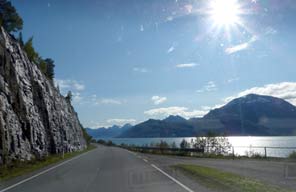 A nostalgic return to Skibotn Camping: quickly ashore at Olderdalen
on the far side, we turned south on the E6 for the route taken last year around
the long recess of Kåfjord and down to Skibotn. Along the northern fjord-side
through Trollvik, we paused to gaze across the fjord at the overwhelming
mountainous massif whose precipitous craggy wall 100s of metres high filled
Kåfjord's southern vista (Photo 23 - Precipitous mountain massif on southern
face of Kåfjord). Streaks of water courses cascaded down the face toppling
from glaciers which filled the high hanging valleys, a truly awesome spectacle. At Birtavarre, we rounded Kåfjord's innermost botn to begin the return
drive along the southern shore, and almost immediately the E6 road was forced
through 2 lengthy tunnels by the obstacle of the mountainous massif wall which
towered above. By now the weather was improving but the distant view down the
fjord of the Lyngen Alps' line of conical peaks and glaciers was still
cloud-covered, with the tiny speck of the ferry A nostalgic return to Skibotn Camping: quickly ashore at Olderdalen
on the far side, we turned south on the E6 for the route taken last year around
the long recess of Kåfjord and down to Skibotn. Along the northern fjord-side
through Trollvik, we paused to gaze across the fjord at the overwhelming
mountainous massif whose precipitous craggy wall 100s of metres high filled
Kåfjord's southern vista (Photo 23 - Precipitous mountain massif on southern
face of Kåfjord). Streaks of water courses cascaded down the face toppling
from glaciers which filled the high hanging valleys, a truly awesome spectacle. At Birtavarre, we rounded Kåfjord's innermost botn to begin the return
drive along the southern shore, and almost immediately the E6 road was forced
through 2 lengthy tunnels by the obstacle of the mountainous massif wall which
towered above. By now the weather was improving but the distant view down the
fjord of the Lyngen Alps' line of conical peaks and glaciers was still
cloud-covered, with the tiny speck of the ferry
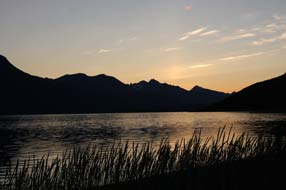 crossing back to Olderdalen.
Rounding the tip of the headland, we began the final 25kms drive along the
eastern shore of Storfjorden, the cloud now suddenly evaporating to give bright
sun lighting the magnificent vista of the southern Lyngen Alps' glaciated peaks
on the far side of the fjord (see right). Around 5-30pm we finally reached Skibotn and just
beyond the little fishing-harbour, pulled into the NAF campsite; we still had
fond memories of our stay there last year. Although rather expensive for a
straightforward campsite, it is the fjord-side setting and mountain panorama
which makes Skibotn such a special place. Not only was the sun shining but our
grass-fringed fjord-side pitch used last year was empty and we quickly settled in to brew tea
(Photo 24 - Grass-fringed fjord-side pitch at Skibotn Camping ).
The late afternoon sun lit the dome-shaped massif at the head of Skibotn valley
and silhouetted the serrated parade of Lyngen Alps peaks along the far side of
the fjord. Despite the clear evening sky, the high
mountains opposite denied us a direct line of sight of the Midnight Sun. We did
however stay up till past midnight to photograph the bright salmon-pink
afterglow of the sun, still above the unseen horizon hidden behind the line of
mountains (Photo 25 - After-glow of setting sun behind Lyngen Alps at Skibotn).
This was the nearest we should get this year to witnessing the Midnight Sun. crossing back to Olderdalen.
Rounding the tip of the headland, we began the final 25kms drive along the
eastern shore of Storfjorden, the cloud now suddenly evaporating to give bright
sun lighting the magnificent vista of the southern Lyngen Alps' glaciated peaks
on the far side of the fjord (see right). Around 5-30pm we finally reached Skibotn and just
beyond the little fishing-harbour, pulled into the NAF campsite; we still had
fond memories of our stay there last year. Although rather expensive for a
straightforward campsite, it is the fjord-side setting and mountain panorama
which makes Skibotn such a special place. Not only was the sun shining but our
grass-fringed fjord-side pitch used last year was empty and we quickly settled in to brew tea
(Photo 24 - Grass-fringed fjord-side pitch at Skibotn Camping ).
The late afternoon sun lit the dome-shaped massif at the head of Skibotn valley
and silhouetted the serrated parade of Lyngen Alps peaks along the far side of
the fjord. Despite the clear evening sky, the high
mountains opposite denied us a direct line of sight of the Midnight Sun. We did
however stay up till past midnight to photograph the bright salmon-pink
afterglow of the sun, still above the unseen horizon hidden behind the line of
mountains (Photo 25 - After-glow of setting sun behind Lyngen Alps at Skibotn).
This was the nearest we should get this year to witnessing the Midnight Sun.
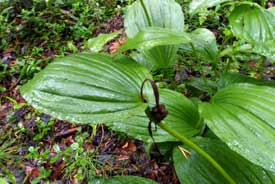 A wet re-visit to Lulledalen Nature Trail:
overnight the cloud had gathered again covering the surrounding mountains (Photo
26 - A thoroughly wet morning at Skibotn Camping); there
were no fjord-side breakfast photos this morning and instead we were inside with the
heater on. Leaving Skibotn, we turned up onto the E8 climbing into Skibotndalen
but this morning the mighty wall of mountains and glaciers enclosing the valley wall were invisible behind a A wet re-visit to Lulledalen Nature Trail:
overnight the cloud had gathered again covering the surrounding mountains (Photo
26 - A thoroughly wet morning at Skibotn Camping); there
were no fjord-side breakfast photos this morning and instead we were inside with the
heater on. Leaving Skibotn, we turned up onto the E8 climbing into Skibotndalen
but this morning the mighty wall of mountains and glaciers enclosing the valley wall were invisible behind a
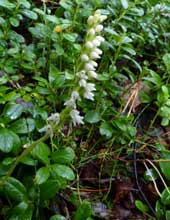 mask of gloomy low cloud. As we gained
height up the valley the rain started; it was going to be a wet walk for our
revisit to the Lulledalen Nature Trail where we hoped this year, a month earlier
than last year's visit, to find the Lady Slipper Orchids still in bloom. 10kms
on, and with satisfying precision, we identified the obscure turn-off, but the Lulledalen forests looked wet and uninviting. At the car park, we kitted up with
full waterproofs for the 3km circuit over the fell-side. With steady rain
dripping from the trees we set off up through the forest, finding ripening
lingonberries, perhaps the last we should see this year (Photo 27 - Ripening lingonberries at Lulledalen Nature Trail).
Reaching the high point, exactly where recalled from last year, we found the
bushes of Lady Slipper Orchids, but disappointment: the distinctive flowers were
already past with just the shrivelled dark remains still showing among the
leaves (see right). A little further we found more of the Creeping Lady's Tresses Orchids
still in bud (see left); the useful thing about wearing over-trousers is that you can kneel on
the wet forest floor for flora close-ups without getting muddy knees! We
followed the path back over the fell-top and down through the forest with rain
still falling and dripping from the trees; today it was a soaking with little
reward, and back at George we stowed wet boots and kit to return to the E8 to
continue up the valley towards the Finnish border with dense rain clouds totally
obscuring the mountains. mask of gloomy low cloud. As we gained
height up the valley the rain started; it was going to be a wet walk for our
revisit to the Lulledalen Nature Trail where we hoped this year, a month earlier
than last year's visit, to find the Lady Slipper Orchids still in bloom. 10kms
on, and with satisfying precision, we identified the obscure turn-off, but the Lulledalen forests looked wet and uninviting. At the car park, we kitted up with
full waterproofs for the 3km circuit over the fell-side. With steady rain
dripping from the trees we set off up through the forest, finding ripening
lingonberries, perhaps the last we should see this year (Photo 27 - Ripening lingonberries at Lulledalen Nature Trail).
Reaching the high point, exactly where recalled from last year, we found the
bushes of Lady Slipper Orchids, but disappointment: the distinctive flowers were
already past with just the shrivelled dark remains still showing among the
leaves (see right). A little further we found more of the Creeping Lady's Tresses Orchids
still in bud (see left); the useful thing about wearing over-trousers is that you can kneel on
the wet forest floor for flora close-ups without getting muddy knees! We
followed the path back over the fell-top and down through the forest with rain
still falling and dripping from the trees; today it was a soaking with little
reward, and back at George we stowed wet boots and kit to return to the E8 to
continue up the valley towards the Finnish border with dense rain clouds totally
obscuring the mountains.
Crossing the Finnish border to camp at
Kilpisjärvi: the E8 road gained impressive height up the valley,
winding up onto the tundra plateau looking even bleaker than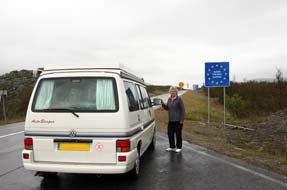 usual in the murky
rain-cloud. After a brief pause at the Finnish border for photos (Photo 28 - Crossing the Norwegian~Finnish border at Kilpisjärvi),
we crossed into this remote NW arm of Finland, almost immediately passing
the reindeer husbandry warning sign; but all the reindeer had sensibly stayed at
home in this filthy, wet weather. With rain-cloud obscuring all the surrounding
hills and Saana fell totally hidden, we reached the Kilpisjärvi Retkeilykeskus
(Hiking Centre) 5 kms further on, but no wonderful views across Lake Kilpisjärvi to
the Swedish mountains beyond today. We fetched out the Euros and went into
reception to book in; the young lass greeted us hospitably saying we were the
first English visitors she had seen. The restorative power of a smiling welcome
is a wonderful human feature when you're tired, wet and cold. All campsite staff
should be taught this; remarkably few are! We pitched up on the first terrace
and pulled out the awning against the pouring rain, stowing our wet kit in a
soggy bundle to await a fine day for drying. With the confusing hour difference
between Norwegian/Swedish time and Finnish tine, we decided to stay with the
former for our brief 24 hour stay at Kilpisjärvi before re-crossing to Sweden
tomorrow; the friendly girl at reception had joked we were 'still living in the
past!' Hot showers, a change into dry clothes, the heater on full and a warming
supper restored a feeling of well-being. With rain still falling and low cloud
enveloping the surrounding fells, it was a thoroughly miserable evening with
zero possibility of seeing the double sunset effect behind Malla Fell
observed last year. usual in the murky
rain-cloud. After a brief pause at the Finnish border for photos (Photo 28 - Crossing the Norwegian~Finnish border at Kilpisjärvi),
we crossed into this remote NW arm of Finland, almost immediately passing
the reindeer husbandry warning sign; but all the reindeer had sensibly stayed at
home in this filthy, wet weather. With rain-cloud obscuring all the surrounding
hills and Saana fell totally hidden, we reached the Kilpisjärvi Retkeilykeskus
(Hiking Centre) 5 kms further on, but no wonderful views across Lake Kilpisjärvi to
the Swedish mountains beyond today. We fetched out the Euros and went into
reception to book in; the young lass greeted us hospitably saying we were the
first English visitors she had seen. The restorative power of a smiling welcome
is a wonderful human feature when you're tired, wet and cold. All campsite staff
should be taught this; remarkably few are! We pitched up on the first terrace
and pulled out the awning against the pouring rain, stowing our wet kit in a
soggy bundle to await a fine day for drying. With the confusing hour difference
between Norwegian/Swedish time and Finnish tine, we decided to stay with the
former for our brief 24 hour stay at Kilpisjärvi before re-crossing to Sweden
tomorrow; the friendly girl at reception had joked we were 'still living in the
past!' Hot showers, a change into dry clothes, the heater on full and a warming
supper restored a feeling of well-being. With rain still falling and low cloud
enveloping the surrounding fells, it was a thoroughly miserable evening with
zero possibility of seeing the double sunset effect behind Malla Fell
observed last year.
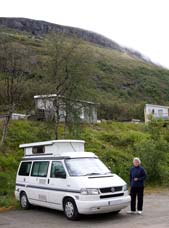 Re-crossing to Northern Sweden at Karesuando:
the phone-alarm had been set for 0700, but the mobile had automatically
re-logged itself to Finnish time; the result was that we were woken in effect at
0600 Swedish time. Disorientating as this was, it did give us an early start to
the day! Our plan was for a morning's work in camp then drive down the Könkämä
valley to re-cross the Finnish~Swedish border at Karesuando. The weather was
still heavily overcast with frequent showers and a bitterly cold Arctic wind
blowing from the Norwegian mountains (Photo 29 - Arctic weather at Kilpisjärvi Hiking Centre). All the reindeer, which in last August's
warm sunshine and blue skies had trit-trotted through the campsite, this year
were marked by their absence, perhaps still up in their mountain pastures. After
lunch, we set off down the border-valley, stopping at Kilpisjärvi 'village' (a
filling station, supermarket, hotels and few Sámi huts) to shop at the K-Market for
Finnish foodstuffs nostalgically recalled from last year. Spending our remaining
Euros and with a departing Kiitos, näkemiin, we continued south-easterly
along the length of Kilpisjärvi lake. The road undulated a dead straight course
across the barren tundra fell-scape, today looking bleak and barren in the
overcast conditions and totally deserted apart from a few remote Sámi
farmsteads. The dark and gloomy grey-green tundra, treeless and bare apart from
rough scrub and boulder-fields had a stark beauty of its own, stretched away
into the misty distance towards low hills. We made good progress with the 100km
drive and, approaching Kaaresuvanto on the Finnish side of the river-border,
suddenly reached the tree-line as we crossed the Lätäseno; this wide river
drains a huge area of the deserted fell-land wastes of Finland's remote NW
corner to merge with the Könkämä just before Karesuando to become the Muonio
River.
Crossing the Muonio bridge, we re-entered Sweden at its northernmost settlement
of Karesuando to re-join our old friend the E45 Inlandsvägen here at the very
top of its
passage up the length of central and northern Sweden. Re-crossing to Northern Sweden at Karesuando:
the phone-alarm had been set for 0700, but the mobile had automatically
re-logged itself to Finnish time; the result was that we were woken in effect at
0600 Swedish time. Disorientating as this was, it did give us an early start to
the day! Our plan was for a morning's work in camp then drive down the Könkämä
valley to re-cross the Finnish~Swedish border at Karesuando. The weather was
still heavily overcast with frequent showers and a bitterly cold Arctic wind
blowing from the Norwegian mountains (Photo 29 - Arctic weather at Kilpisjärvi Hiking Centre). All the reindeer, which in last August's
warm sunshine and blue skies had trit-trotted through the campsite, this year
were marked by their absence, perhaps still up in their mountain pastures. After
lunch, we set off down the border-valley, stopping at Kilpisjärvi 'village' (a
filling station, supermarket, hotels and few Sámi huts) to shop at the K-Market for
Finnish foodstuffs nostalgically recalled from last year. Spending our remaining
Euros and with a departing Kiitos, näkemiin, we continued south-easterly
along the length of Kilpisjärvi lake. The road undulated a dead straight course
across the barren tundra fell-scape, today looking bleak and barren in the
overcast conditions and totally deserted apart from a few remote Sámi
farmsteads. The dark and gloomy grey-green tundra, treeless and bare apart from
rough scrub and boulder-fields had a stark beauty of its own, stretched away
into the misty distance towards low hills. We made good progress with the 100km
drive and, approaching Kaaresuvanto on the Finnish side of the river-border,
suddenly reached the tree-line as we crossed the Lätäseno; this wide river
drains a huge area of the deserted fell-land wastes of Finland's remote NW
corner to merge with the Könkämä just before Karesuando to become the Muonio
River.
Crossing the Muonio bridge, we re-entered Sweden at its northernmost settlement
of Karesuando to re-join our old friend the E45 Inlandsvägen here at the very
top of its
passage up the length of central and northern Sweden.
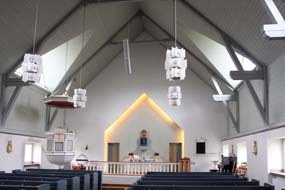 Karesuando, Sweden's northernmost settlement:
remote Karesuando,
180kms north of Kiruna,
is very much a Sámi reindeer husbandry centre just at the edge of the
tree-line. Winters are long, dark and severely cold with the first snows falling
at the beginning of October and lasting until late May. In winter, temperatures
fall to -20°C, the Muonio freezes over and permafrost grips the earth just a few
cms below the surface; in summer midges swarm around the village along the river
banks. Four languages are spoken in this northern area of the Tornedalen valley: Swedish,
Finnish, Sámi and Karesuando, Sweden's northernmost settlement:
remote Karesuando,
180kms north of Kiruna,
is very much a Sámi reindeer husbandry centre just at the edge of the
tree-line. Winters are long, dark and severely cold with the first snows falling
at the beginning of October and lasting until late May. In winter, temperatures
fall to -20°C, the Muonio freezes over and permafrost grips the earth just a few
cms below the surface; in summer midges swarm around the village along the river
banks. Four languages are spoken in this northern area of the Tornedalen valley: Swedish,
Finnish, Sámi and
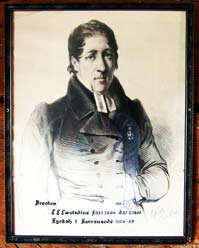 Meänkieli, the local dialect of Tornedalen-Finnish. Just across
on the Swedish side of the bridge, we stopped to visit Karesuando's wooden
church built in 1816. Until the present border's creation with Finland's
separation in 1809, the parish of Karesuando stretched as far as Enontekiö. The
church's plain white interior had a calming air (see right), the one decoration being a
small sculpture behind the altar showing a crucifix along with a representation
of Lars Levi Laestadius, the revivalist preacher who was rector of Karesuando
from 1826~49 (see left). Laestadius devoted his life to saving the Sámi and Northern Swedes
from the demon drink at a time when alcoholism was a scourge in these northern
lands. His sermons must have been a real bundle of joy in the bitterly cold
permanent darkness of winter without the warmth of a drink to look forward to.
His evangelically puritanical teachings, still followed by 1000s in Northern Sweden,
even banned curtains from houses since sin lurks behind curtains! Duly
chastened, but looking forward to our evening beer, we photographed the church,
then drove around the village to find the stark wooden hut which had served as Laestadius' rectory. The preserved little wooden cottage, sans curtains, was now
set out as a meeting-chapel (Photo 30 - Lars Levi Laestadius' preserved rectory at Karesuando), and peering through the gap in the timbers in the
store room at the back, we half expected to see a secret cache of empty bottles.
We had the luxury of 2 campsite options in Karesuando: Sandlövs Camping in the
village centre just across the bridge opposite the church came with a good
recommendation from Barry and Margaret Williamson's Magbaz travel website
as a 'charmingly simple site with friendly owner and price' but today this was
rather full; the other option, Karesuando Camping a couple of kms along Route
99 with a flat, grassy camping area on the banks of the Muonio, looked
attractive and the price of 200kr/night all-in was perhaps influenced by
competition from the more centrally sited Sandlövs Camping. The owner was
welcoming, the facilities fine and we chose this campsite, quickly settling in
to escape from Karesuando's swarming midges. Meänkieli, the local dialect of Tornedalen-Finnish. Just across
on the Swedish side of the bridge, we stopped to visit Karesuando's wooden
church built in 1816. Until the present border's creation with Finland's
separation in 1809, the parish of Karesuando stretched as far as Enontekiö. The
church's plain white interior had a calming air (see right), the one decoration being a
small sculpture behind the altar showing a crucifix along with a representation
of Lars Levi Laestadius, the revivalist preacher who was rector of Karesuando
from 1826~49 (see left). Laestadius devoted his life to saving the Sámi and Northern Swedes
from the demon drink at a time when alcoholism was a scourge in these northern
lands. His sermons must have been a real bundle of joy in the bitterly cold
permanent darkness of winter without the warmth of a drink to look forward to.
His evangelically puritanical teachings, still followed by 1000s in Northern Sweden,
even banned curtains from houses since sin lurks behind curtains! Duly
chastened, but looking forward to our evening beer, we photographed the church,
then drove around the village to find the stark wooden hut which had served as Laestadius' rectory. The preserved little wooden cottage, sans curtains, was now
set out as a meeting-chapel (Photo 30 - Lars Levi Laestadius' preserved rectory at Karesuando), and peering through the gap in the timbers in the
store room at the back, we half expected to see a secret cache of empty bottles.
We had the luxury of 2 campsite options in Karesuando: Sandlövs Camping in the
village centre just across the bridge opposite the church came with a good
recommendation from Barry and Margaret Williamson's Magbaz travel website
as a 'charmingly simple site with friendly owner and price' but today this was
rather full; the other option, Karesuando Camping a couple of kms along Route
99 with a flat, grassy camping area on the banks of the Muonio, looked
attractive and the price of 200kr/night all-in was perhaps influenced by
competition from the more centrally sited Sandlövs Camping. The owner was
welcoming, the facilities fine and we chose this campsite, quickly settling in
to escape from Karesuando's swarming midges.
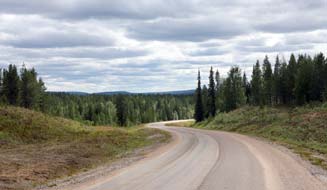 A lonely drive along the Tornedalen valley:
leaving Karesuando the following morning, we turned SE for the 180km long lonely
drive along the Swedish side of the border with Finland down the length of the
Tornedalen valley to Pajala (see right). Initially running parallel with the Muonio River,
this was a reasonably surfaced but narrow and very lonely road. With nothing but
an occasional tiny Sámi settlement, there was nothing but everlasting forest
stretching away to the horizon with little sign of life and just the occasional
lake as a marker of progress, and no other traffic for company along this empty,
deserted road through this endless forested wilderness (Photo 31 - A lonely
forest drive along the Tornedalen valley). A lonely drive along the Tornedalen valley:
leaving Karesuando the following morning, we turned SE for the 180km long lonely
drive along the Swedish side of the border with Finland down the length of the
Tornedalen valley to Pajala (see right). Initially running parallel with the Muonio River,
this was a reasonably surfaced but narrow and very lonely road. With nothing but
an occasional tiny Sámi settlement, there was nothing but everlasting forest
stretching away to the horizon with little sign of life and just the occasional
lake as a marker of progress, and no other traffic for company along this empty,
deserted road through this endless forested wilderness (Photo 31 - A lonely
forest drive along the Tornedalen valley).
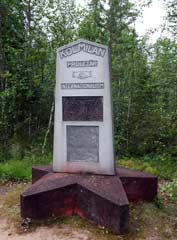 We eventually reached
the small Sämi village of Muodoslompolo where an unsurfaced lane branched off to
cross the river-border to Muonio on the Finnish bank. Then it was back to the
empty forests, slightly more open now with sandy heathland, and with the weather
brighter the wilderness surroundings seemed less gloomy and all-enveloping. But
the map showed totally uninhabited wilderness stretching away for miles
westwards, broken only by the last section of the E45 cutting its lonely way
north to the Swedish outpost of Karesuando. And westwards beyond that, further
even more extensive empty tundra stretching to the mountains of Norway. This was
indeed truly empty wilderness, devoid of human life or habitation (see maps at
head of page). We eventually reached
the small Sämi village of Muodoslompolo where an unsurfaced lane branched off to
cross the river-border to Muonio on the Finnish bank. Then it was back to the
empty forests, slightly more open now with sandy heathland, and with the weather
brighter the wilderness surroundings seemed less gloomy and all-enveloping. But
the map showed totally uninhabited wilderness stretching away for miles
westwards, broken only by the last section of the E45 cutting its lonely way
north to the Swedish outpost of Karesuando. And westwards beyond that, further
even more extensive empty tundra stretching to the mountains of Norway. This was
indeed truly empty wilderness, devoid of human life or habitation (see maps at
head of page).
Continuing SE on Route 99, and leaving the more
dense and gloomy forests of further north, we began to pass through occasional
Sámi reindeer herding settlements all with Finnish-sounding names ending in -järvi
and -joki. The river was wider now with the occasional boat, there were more
farms, more signs of life and occasional reindeer along the road. Just before
the village of Kaalamakoski, we pulled into a lay-by where a sign pointed to a
war memorial in the forest; topped with the words Kolmilan Proletär
Internationalism, the memorial pictorial plaque seemed to show a massacre with
soldiers executing kneeling figures and a lengthily worded but unintelligible
inscription (see left). There was no information panel and for the moment we were left
wondering what brutal episode this now forgotten memorial half-buried in the
forest and cut off by reindeer fencing might recall. For now we continued our
drive and just north of Pajala passed a brown sign pointing to a Struve Geodetic
monument just off the road; again we left that hoping to find out more at the
TIC when we reached the town.
 Pajala, a fascinating town with a first class
Tourist Information Centre: crossing the Torneälven river and reaching the centre of Pajala, not only
was the TIC open but staffed by a delightfully charming and fluently
English-speaking lady with an encyclopaedic knowledge relating to Pajala, and
endless patience in answering our many questions. From her we learnt that the
Kaalama war memorial seen earlier had been erected after WW2 to commemorate a
group of Finnish communist guerrilla fighters; they had been harrying the
retreating Germans in September 1944 and had sought sanctuary across on the
Swedish side of the border. Left wing sympathisers had fed and hidden them, but
they were betrayed and massacred in the forest, by whom (perhaps Germans
illicitly crossing the border) we still have been unable to discover; any
information from readers would be welcome. She did add
that strong left-wing views still predominated in Pajala. She did of course know all
about the Struve Geodetic Arc and the monument at Jupukka just to the north of
the town marking one of the 265 triangulation points between Hammerfest in
Northern Norway and the Black Sea used in the mid-19th century by Friedrich
Struve to plot the arc of the global meridian (see our 2012 log),
and described the nature walk leading to the site at Jupukka. She was Finnish
from Kolari just across the border and told us more about the cross-Finnish~Swedish
dialect of Meänkieli spoken by some 50,000 people along the Tornedalen
borderlands and one of Sweden's officially recognised minority languages; she
explained some of Meänkieli's subtleties for describing the various conditions
of snow Pajala, a fascinating town with a first class
Tourist Information Centre: crossing the Torneälven river and reaching the centre of Pajala, not only
was the TIC open but staffed by a delightfully charming and fluently
English-speaking lady with an encyclopaedic knowledge relating to Pajala, and
endless patience in answering our many questions. From her we learnt that the
Kaalama war memorial seen earlier had been erected after WW2 to commemorate a
group of Finnish communist guerrilla fighters; they had been harrying the
retreating Germans in September 1944 and had sought sanctuary across on the
Swedish side of the border. Left wing sympathisers had fed and hidden them, but
they were betrayed and massacred in the forest, by whom (perhaps Germans
illicitly crossing the border) we still have been unable to discover; any
information from readers would be welcome. She did add
that strong left-wing views still predominated in Pajala. She did of course know all
about the Struve Geodetic Arc and the monument at Jupukka just to the north of
the town marking one of the 265 triangulation points between Hammerfest in
Northern Norway and the Black Sea used in the mid-19th century by Friedrich
Struve to plot the arc of the global meridian (see our 2012 log),
and described the nature walk leading to the site at Jupukka. She was Finnish
from Kolari just across the border and told us more about the cross-Finnish~Swedish
dialect of Meänkieli spoken by some 50,000 people along the Tornedalen
borderlands and one of Sweden's officially recognised minority languages; she
explained some of Meänkieli's subtleties for describing the various conditions
of snow
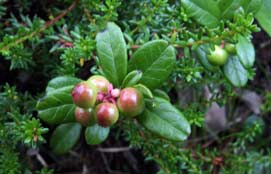 which are lost in English translation - soft snow for making snow-balls,
hard-packed snow fit for walking on. This led on to our asking about the rival
districts of the town of Pajala mentioned in Mikael Niemi's Swedish novel
Popular Music from Vittula which we had been reading in English translation;
this bitter-sweet coming-of-age story recounts the trials and tribulations of a
teenager Matti and his friend Niila growing up in the 1960s in the remote town
of Pajala and their aspirations to become pop stars. Vittula, she explained with
evident embarrassment, was not only a district in Pajala but in Finnish
resembled the commonly used obscenity vittu, an ambiguity
totally lost in
the English translation; she added that her mother, on seeing the film of the
novel, was too embarrassed even to use the word Vittula! This had for us
been a wonderfully educative encounter; Pajala's TIC ranked with others like
Nora in our competition for Sweden's top-ranking Tourist Information Centre. which are lost in English translation - soft snow for making snow-balls,
hard-packed snow fit for walking on. This led on to our asking about the rival
districts of the town of Pajala mentioned in Mikael Niemi's Swedish novel
Popular Music from Vittula which we had been reading in English translation;
this bitter-sweet coming-of-age story recounts the trials and tribulations of a
teenager Matti and his friend Niila growing up in the 1960s in the remote town
of Pajala and their aspirations to become pop stars. Vittula, she explained with
evident embarrassment, was not only a district in Pajala but in Finnish
resembled the commonly used obscenity vittu, an ambiguity
totally lost in
the English translation; she added that her mother, on seeing the film of the
novel, was too embarrassed even to use the word Vittula! This had for us
been a wonderfully educative encounter; Pajala's TIC ranked with others like
Nora in our competition for Sweden's top-ranking Tourist Information Centre.
The
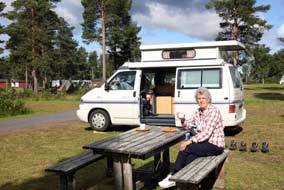 Jupukka Struve Geodetic monument:
since it was still only 4-30pm, we decided before heading for Pajala's campsite
to return north of the town to the hill Jupukka and find what we believed would
be another monument to Struve's ground-breaking geodetic work, the sites of his
triangulation measurements now recognised with World Heritage status. From a
parking area 200m along a dirt road a path rose steeply for almost 1km to the
brow of a hill; there was no memorial, just a small information panel at the
point where Struve's minions must have made their calculations (see above right). But the swarming
midges were simply too much and contenting ourselves with photographing the
views of distant forests and of the ripening lingonberries lining the path (see
left),
we returned into the town. Jupukka Struve Geodetic monument:
since it was still only 4-30pm, we decided before heading for Pajala's campsite
to return north of the town to the hill Jupukka and find what we believed would
be another monument to Struve's ground-breaking geodetic work, the sites of his
triangulation measurements now recognised with World Heritage status. From a
parking area 200m along a dirt road a path rose steeply for almost 1km to the
brow of a hill; there was no memorial, just a small information panel at the
point where Struve's minions must have made their calculations (see above right). But the swarming
midges were simply too much and contenting ourselves with photographing the
views of distant forests and of the ripening lingonberries lining the path (see
left),
we returned into the town.
Pajala Camping, another first class campsite:
just beyond the modern bridge over the wide Torneälven, we were welcomed at the
riverside campsite with its 3 camping areas laid out in commendable fashion: a
tarmaced and sanitised enclosure to corral the Norwegian mega-buses and
ludicrously over-materialistic caravans, a broad grassy area for tents, and a
beautifully secluded riverside area in a forested glade for more discerning
campers. We pitched here next to an area of pines, the forest floor studded with
lingonberries and ripe bilberries for breakfast (see right); even the midges seemed to have
disappeared. We were looking forward to a restful day in camp tomorrow at this
beautifully peaceful, forested riverside setting. We woke the
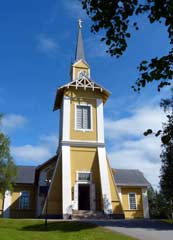 following morning
to warm sunshine at last to spread out wet boots and kit to dry, hang out the
sleeping bags to air, and sit out for a midge-free breakfast; dared we hope that
the midge season was coming to an end? We enjoyed a satisfyingly restful day at Pajala Camping (Photo 32 - Rest day at Pajala Camping), catching up with chores and using the washing machine; almost
out of the Arctic now, by evening the sky grew dusky and the day ended with a
spectacularly flaring sunset across the river filling the sky with a golden-pink
array (Photo 33 - A spectacular sunset at Pajala Camping). following morning
to warm sunshine at last to spread out wet boots and kit to dry, hang out the
sleeping bags to air, and sit out for a midge-free breakfast; dared we hope that
the midge season was coming to an end? We enjoyed a satisfyingly restful day at Pajala Camping (Photo 32 - Rest day at Pajala Camping), catching up with chores and using the washing machine; almost
out of the Arctic now, by evening the sky grew dusky and the day ended with a
spectacularly flaring sunset across the river filling the sky with a golden-pink
array (Photo 33 - A spectacular sunset at Pajala Camping).
The town of Pajala: before continuing
south today to re-cross the Arctic Circle, we drove into Pajala to explore this
remote little town on the banks of the Torneälven river and the rival districts
of Paskjänkka and Vittula described so vividly in the novel Popular Music
from Vittula. We drove through what today seemed just like any other
pleasant estate of classy bungalows with neatly kept front gardens and smart
Volvos parked on the drives; perhaps today's residents of Vittula are also
unaware of their neighbourhood's obscene-sounding name. And despite the fact
that Lars Levi Laestadius was also rector here in Pajala and is buried in the
town's graveyard, all the bungalows these days had curtains. Nearby set on a
grassy hillock among tall pines and birches, we found Pajala's ochre-painted
wooden church (see left) built in 1871 to replace the old church close to the iron foundry
at Kengis Bruk. The modern furnished interior was soothingly plain with its
light wood pews and devoid of all decoration save for a 1942 altar painting and
bulbous pulpit brought from the old church. Into the town centre, we parked by
the shops to visit the Pajala Sun Square, claimed as the world's largest sun
dial fully 38m in diameter. The Midnight Sun's 24 hours' light casts the shadow
of the tall gnomon, angled like the Earth's axis, against the full 360° of hour
posts (Photo 34 - 38m diameter sun dial in the town square at Pajala).
The town had here achieved a worthy curiosity. Before leaving Pajala, we shopped
for further provisions at the Co-op-Konsum, noticing how all the shops had dual
language Finnish~Swedish signs and posters.
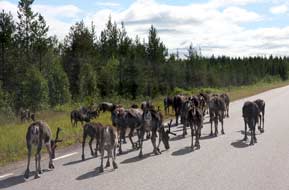 South to re-cross the Arctic Circle along the
Kalix river valley: leaving Pajala, we turned south onto Route 392 a
road which, although passing through deserted forests, was not such a lonely
road as Route 99 from Karesuando; there was more traffic and bus stops showed
there were regular buses serving the Sámi settlements along the road. At one
point we were brought to a standstill by a large herd of reindeer ambling along
the road (see right), including a number of this year's young calves with their mothers South to re-cross the Arctic Circle along the
Kalix river valley: leaving Pajala, we turned south onto Route 392 a
road which, although passing through deserted forests, was not such a lonely
road as Route 99 from Karesuando; there was more traffic and bus stops showed
there were regular buses serving the Sámi settlements along the road. At one
point we were brought to a standstill by a large herd of reindeer ambling along
the road (see right), including a number of this year's young calves with their mothers
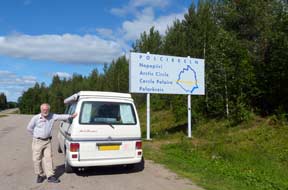 (Photo
35 - Roadside reindeer along Route 392). Beyond
the larger village of Korpilombolo, we continued for mile after mile through the
empty forest which stretched away into the distance, and 78kms from Pajala,
Route 392 reached the wide Kalixälven, one of Sweden's 4 unexploited rivers, and
turned south along its valley. The forested terrain was more pastoral here with
cattle grazing on farms along the river banks. 5km further along the valley and
we pulled into a lay-by at N-66.55332 E-22.75949 where the notional line of the
Arctic Circle crossed the road (Photo 36 - Re-crossing the Arctic Circle southwards).
This year we had spent only 3 weeks inside the Arctic and had not seen the
Midnight Sun once due to cloudy weather and the horizon impeded by forests. (Photo
35 - Roadside reindeer along Route 392). Beyond
the larger village of Korpilombolo, we continued for mile after mile through the
empty forest which stretched away into the distance, and 78kms from Pajala,
Route 392 reached the wide Kalixälven, one of Sweden's 4 unexploited rivers, and
turned south along its valley. The forested terrain was more pastoral here with
cattle grazing on farms along the river banks. 5km further along the valley and
we pulled into a lay-by at N-66.55332 E-22.75949 where the notional line of the
Arctic Circle crossed the road (Photo 36 - Re-crossing the Arctic Circle southwards).
This year we had spent only 3 weeks inside the Arctic and had not seen the
Midnight Sun once due to cloudy weather and the horizon impeded by forests.
Next week we reach Luleå at the head of the Bothnian
Gulf to begin the long drive down Sweden's eastern seaboard along the coast of
the Baltic into Central Sweden. On the way we shall visit Piteå, the Storfossen
Rapids on the Piteälven river, Skellefteå, Umeå, the High Coast National Park,
Sundsvall, Hudiksvall, and Sweden's National Railway Museum at Gävle. After our time in the Arctic and Northern
wildness lands this all will be something of a culture shock. Follow us again in the next edition as we continue our journey
south.
Next edition
to be published shortly
|
Sheila and Paul |
Published: 20 November 2013 |
|
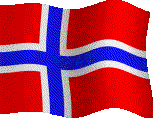

 CAMPING
IN NORTHERN NORWAY, NW FINLAND, and SWEDEN 2013 - across into Northern Norway, the iron ore port of Narvik, north
to Tromsø, across
the fjords to Skibotn, Kilpisjärvi in NW Finland, return to Northern Sweden at
Karesuando and down the Tornedalen valley to Pajala, south to re-cross the
Arctic Circle in the Kalix Valley:
CAMPING
IN NORTHERN NORWAY, NW FINLAND, and SWEDEN 2013 - across into Northern Norway, the iron ore port of Narvik, north
to Tromsø, across
the fjords to Skibotn, Kilpisjärvi in NW Finland, return to Northern Sweden at
Karesuando and down the Tornedalen valley to Pajala, south to re-cross the
Arctic Circle in the Kalix Valley: Into Northern Norway to Narvik: with
cheerless Arctic grey cloud obscuring the surrounding fells, we crossed the
open border into Norway just beyond Riksgränsen; immediately we were in a
different world leaving behind the high plateau fell-scape of Sweden and soon
starting a steep descent in severely mountainous terrain surrounded by imposing
snow-flecked peaks. The narrow road rounded into a craggy ravine, wispy cloud
hovering around the backdrop of peaks as we descended steeply towards the
fjord-inlet to approach the junction with the main E6 highway. Turning south to
cross the suspension bridge over the fjord narrows (see left), we headed along the southern
loch-shore towards Narvik, surprised at the stark mountainous countryside
surrounding the little port which snuggled into the inner fjord with peaks
rising steeply on all sides.
Into Northern Norway to Narvik: with
cheerless Arctic grey cloud obscuring the surrounding fells, we crossed the
open border into Norway just beyond Riksgränsen; immediately we were in a
different world leaving behind the high plateau fell-scape of Sweden and soon
starting a steep descent in severely mountainous terrain surrounded by imposing
snow-flecked peaks. The narrow road rounded into a craggy ravine, wispy cloud
hovering around the backdrop of peaks as we descended steeply towards the
fjord-inlet to approach the junction with the main E6 highway. Turning south to
cross the suspension bridge over the fjord narrows (see left), we headed along the southern
loch-shore towards Narvik, surprised at the stark mountainous countryside
surrounding the little port which snuggled into the inner fjord with peaks
rising steeply on all sides. forecourt to check times of trains for our planned rail journey
tomorrow on the Malmbanan/Ofotbanen back up to the Swedish border at Riksgränsen.
The TIC at the station provided a street plan and weather forecast: after a
brief sunny spell tomorrow, the outlook for our stay in Northern Norway was
pessimistically gloomy and wet. Driving around through the town, Narvik's
harbour was dominated by the huge LKAB iron ore terminal on the opposite side of
the fjord with its metallic mass of chutes and piles of rust-coloured ore. On
the far side of the town, the E6 passed through a 2km long tunnel under the
mountains, crossing a side-fjord on a long bridge to a more industrial area
where we found a Rema 1000 supermarket to re-stock with provisions, a
reminder shock of Norwegian food prices. Driving back into the town centre gave
us a full impression of the little port-town nestled around the fjord and
spreading up onto the lower reaches of the surrounding high mountains. Bulk ore
ships were anchored out in the enclosed harbour-fjord awaiting loading with iron
ore transported by train down from the mines at Gällivare and Kiruna (see left).
forecourt to check times of trains for our planned rail journey
tomorrow on the Malmbanan/Ofotbanen back up to the Swedish border at Riksgränsen.
The TIC at the station provided a street plan and weather forecast: after a
brief sunny spell tomorrow, the outlook for our stay in Northern Norway was
pessimistically gloomy and wet. Driving around through the town, Narvik's
harbour was dominated by the huge LKAB iron ore terminal on the opposite side of
the fjord with its metallic mass of chutes and piles of rust-coloured ore. On
the far side of the town, the E6 passed through a 2km long tunnel under the
mountains, crossing a side-fjord on a long bridge to a more industrial area
where we found a Rema 1000 supermarket to re-stock with provisions, a
reminder shock of Norwegian food prices. Driving back into the town centre gave
us a full impression of the little port-town nestled around the fjord and
spreading up onto the lower reaches of the surrounding high mountains. Bulk ore
ships were anchored out in the enclosed harbour-fjord awaiting loading with iron
ore transported by train down from the mines at Gällivare and Kiruna (see left). Sweden had been supplying the Allies with iron ore via the
ice-free port of Narvik. The Germans had sent a fleet of 10 destroyers which in
early April 1940 had entered the port, sunk 2 antiquated and outgunned Norwegian
naval ships and captured the iron ore docks and loaded ore carriers in the
harbour. The following day, a fleet of 5 Royal Navy destroyers reached Narvik
and a fierce naval battle was fought in the harbour with ships on both sides
being sunk. A larger RN fleet arrived, landing British, French and Polish troops
who recaptured the town, driving the Germans into the mountains. Fierce fighting
took place in the mountainous terrain up towards the Swedish border between the
heavily armed Germans and poorly armed Norwegians. The Germans pounded Narvik
with naval bombardment and saturation bombing sinking more vessels in the
fjord-harbour; the Allied forces suffered severe casualties and were hurriedly
evacuated with Hitler's invasion of France in June 1940. The civilian population
Sweden had been supplying the Allies with iron ore via the
ice-free port of Narvik. The Germans had sent a fleet of 10 destroyers which in
early April 1940 had entered the port, sunk 2 antiquated and outgunned Norwegian
naval ships and captured the iron ore docks and loaded ore carriers in the
harbour. The following day, a fleet of 5 Royal Navy destroyers reached Narvik
and a fierce naval battle was fought in the harbour with ships on both sides
being sunk. A larger RN fleet arrived, landing British, French and Polish troops
who recaptured the town, driving the Germans into the mountains. Fierce fighting
took place in the mountainous terrain up towards the Swedish border between the
heavily armed Germans and poorly armed Norwegians. The Germans pounded Narvik
with naval bombardment and saturation bombing sinking more vessels in the
fjord-harbour; the Allied forces suffered severe casualties and were hurriedly
evacuated with Hitler's invasion of France in June 1940. The civilian population had suffered badly during the fighting and bombing and much of the town was
destroyed as well as the port installations and iron ore terminal. With the
Norwegian government's capitulation in June, the Norwegian forces were forced to
surrender despite having pinned down superior German forces in the mountains,
and Narvik now suffered under 5 years of German occupation; Hitler had access to
the Swedish iron ore supply.
had suffered badly during the fighting and bombing and much of the town was
destroyed as well as the port installations and iron ore terminal. With the
Norwegian government's capitulation in June, the Norwegian forces were forced to
surrender despite having pinned down superior German forces in the mountains,
and Narvik now suffered under 5 years of German occupation; Hitler had access to
the Swedish iron ore supply. the air with fine, soaking drizzle, we drove back through
the deserted main street and along the E6 to find Narvik Camping. In this
miserably grim weather with the rain churning the campsite driveway into slurry,
we found a pitch on the uppermost of the 3 camping areas terraced up the steep
hillside overlooking the fjord which was scarcely visible with the cloud cover
down to valley bottom (see right). We could just about make out the railway line on the
opposite hillside with ore trains passing regularly. So far this trip we had not
enjoyed one sighting of the Midnight sun, and in this wretchedly chill weather
we were certainly not going to see it tonight.
the air with fine, soaking drizzle, we drove back through
the deserted main street and along the E6 to find Narvik Camping. In this
miserably grim weather with the rain churning the campsite driveway into slurry,
we found a pitch on the uppermost of the 3 camping areas terraced up the steep
hillside overlooking the fjord which was scarcely visible with the cloud cover
down to valley bottom (see right). We could just about make out the railway line on the
opposite hillside with ore trains passing regularly. So far this trip we had not
enjoyed one sighting of the Midnight sun, and in this wretchedly chill weather
we were certainly not going to see it tonight. below us along the loch-shore and the Rombaksbrua
suspension bridge crossed yesterday soon coming into view through the line-side
trees. The line continued impressively high above Rombaksbotn with the raw,
craggy mountain face opposite streaked with watercourses tumbling down the
near-vertical mountainside (Photo 2 - Ofotsbanan railway curving through mountainous scenery).
After a pause at an isolated station-halt, the train moved off again into
magnificently desolate mountain scenery, and we stood taking photos of these
glorious surroundings from the train windows or from the rear lobby looking back
down the line; our admiration for the builders of this
spectacular line increased a hundredfold. The line passed through short tunnels
and snow-sheds
(Photo 3 - Snow-sheds on the Ofotbanan railway) and just beyond Katterat
a longer tunnel built in 2002 when the original line was rerouted to bypass the
now disused Norddal trestle-viaduct
(Photo 4 - Disused Norddal trestle-viaduct). In 1940
the
below us along the loch-shore and the Rombaksbrua
suspension bridge crossed yesterday soon coming into view through the line-side
trees. The line continued impressively high above Rombaksbotn with the raw,
craggy mountain face opposite streaked with watercourses tumbling down the
near-vertical mountainside (Photo 2 - Ofotsbanan railway curving through mountainous scenery).
After a pause at an isolated station-halt, the train moved off again into
magnificently desolate mountain scenery, and we stood taking photos of these
glorious surroundings from the train windows or from the rear lobby looking back
down the line; our admiration for the builders of this
spectacular line increased a hundredfold. The line passed through short tunnels
and snow-sheds
(Photo 3 - Snow-sheds on the Ofotbanan railway) and just beyond Katterat
a longer tunnel built in 2002 when the original line was rerouted to bypass the
now disused Norddal trestle-viaduct
(Photo 4 - Disused Norddal trestle-viaduct). In 1940
the
 Norwegians had attempted to blow this up to prevent Swedish iron ore
supplies reaching the Germans, but the demolition failed; the Germans soon
repaired the damage to re-open the line for ore traffic. Just after Björnfjall,
the highest station, the train crossed the Swedish border and halted at Riksgränsen
where we got off, the 'station' being little more than a platform partly under a
snow-shed (see left).
Norwegians had attempted to blow this up to prevent Swedish iron ore
supplies reaching the Germans, but the demolition failed; the Germans soon
repaired the damage to re-open the line for ore traffic. Just after Björnfjall,
the highest station, the train crossed the Swedish border and halted at Riksgränsen
where we got off, the 'station' being little more than a platform partly under a
snow-shed (see left).
 we turned off across a new section of road winding over to a new
shopping complex built on reclaimed industrial land amid the ore tips and
sidings of the LKAB terminal area. Above towered the tall brick stanchions of a
former ore delivery system, now partially demolished and replaced in 2009 by the
latest underground silo system. LKAB opened its ore loading terminal at Narvik
harbour in 1903, just 2 years before Norway seceded from union with the Swedish
kingdom. Narvik was chosen as the export port for ore, the harbour being ice-free
all year round and deep enough for large ocean-going bulk ore-carrying ships of
up to 350,000 tons; nowadays 75% of LKAB's total ore production is shipped from
Narvik (see left). Every day 60,000 tons of ore are transported by trains of hopper wagons
each containing 100 tons of ore pellets and hauled by the world's most powerful
electric locos. The new underground silo system at Narvik was blasted out of
solid rock, with each of the 12 silos, 38m in diameter, 60m deep, storing
110,000 tons of ore products (16 train loads). Lines of hopper-wagons are backed
over the silos in a covered tunnel and ore unloaded by remote control, dropping
their contents while the train moves slowly over the silos, each wagon taking
just 5 seconds to deposit its load into the silo. When a ship is ready for
loading, conveyors transport the ore from the silo base into the ship's
containers at the port's 5 ship-loading quays (Photo
8 - Bulk iron ore ship being loaded at Narvik LKAB terminal). The silo-system is claimed
by LKAB environmentally to produce less dust and noise pollution over the town,
and 19 million tons of ore are shipped annually from Narvik, the port handling
around 200 ship-loadings each year to world-wide export destinations.
we turned off across a new section of road winding over to a new
shopping complex built on reclaimed industrial land amid the ore tips and
sidings of the LKAB terminal area. Above towered the tall brick stanchions of a
former ore delivery system, now partially demolished and replaced in 2009 by the
latest underground silo system. LKAB opened its ore loading terminal at Narvik
harbour in 1903, just 2 years before Norway seceded from union with the Swedish
kingdom. Narvik was chosen as the export port for ore, the harbour being ice-free
all year round and deep enough for large ocean-going bulk ore-carrying ships of
up to 350,000 tons; nowadays 75% of LKAB's total ore production is shipped from
Narvik (see left). Every day 60,000 tons of ore are transported by trains of hopper wagons
each containing 100 tons of ore pellets and hauled by the world's most powerful
electric locos. The new underground silo system at Narvik was blasted out of
solid rock, with each of the 12 silos, 38m in diameter, 60m deep, storing
110,000 tons of ore products (16 train loads). Lines of hopper-wagons are backed
over the silos in a covered tunnel and ore unloaded by remote control, dropping
their contents while the train moves slowly over the silos, each wagon taking
just 5 seconds to deposit its load into the silo. When a ship is ready for
loading, conveyors transport the ore from the silo base into the ship's
containers at the port's 5 ship-loading quays (Photo
8 - Bulk iron ore ship being loaded at Narvik LKAB terminal). The silo-system is claimed
by LKAB environmentally to produce less dust and noise pollution over the town,
and 19 million tons of ore are shipped annually from Narvik, the port handling
around 200 ship-loadings each year to world-wide export destinations.  Narvik's war cemetery: before
returning for our second night at Narvik Camping, we paused at the town's large
civic cemetery to find the war graves from the 1940 battles for control of
Narvik. In one corner were the graves and memorial to the French troops killed
in the fighting and on the far side the stark Teutonic crosses of the German war
graves. Tucked away in a remote corner we found the Commonwealth War Graves
Commission cemetery of British soldiers, sailors and airman killed at Narvik
(see right) (Photo
9 - CWGC war cemetery at Narvik),
and next to this a memorial to the Polish war dead; we stood awhile
silently paying our respects, as yet another LKAB iron ore train trundled past
across the hillside on its way to the port.
Narvik's war cemetery: before
returning for our second night at Narvik Camping, we paused at the town's large
civic cemetery to find the war graves from the 1940 battles for control of
Narvik. In one corner were the graves and memorial to the French troops killed
in the fighting and on the far side the stark Teutonic crosses of the German war
graves. Tucked away in a remote corner we found the Commonwealth War Graves
Commission cemetery of British soldiers, sailors and airman killed at Narvik
(see right) (Photo
9 - CWGC war cemetery at Narvik),
and next to this a memorial to the Polish war dead; we stood awhile
silently paying our respects, as yet another LKAB iron ore train trundled past
across the hillside on its way to the port. Heading along the E6, back across the Rombaks
bridge and the north shore of Ofotfjord, we continued north at Bjerkvik where
the E10 turned westwards towards the Lofoten Islands, sowing the seeds of next
year's possible travels to these northern lands. The E6 road began a long, winding
and steep climb up into the mountains to the tree line, and from the high point
descended a similar distance to Storfossen and along a mountain valley towards
Fossbakken (see left), passing a number of the 1940 battle sites where the lightly armed
Norwegian forces had harried the Germans as they had advanced northwards into
the mountainous interior. Defending their homeland against German invaders, the
Norwegians led by General Carl Gustav Fleischer had achieved commendable success
in halting the German advance at Lapphaugen, the first major Allied victory
against German land forces (Photo 10 - Memorial to Norwegian 1940 victory at Lapphaugen).
Here we paused at the memorial commemorating Norwegian successes against
superior German
Heading along the E6, back across the Rombaks
bridge and the north shore of Ofotfjord, we continued north at Bjerkvik where
the E10 turned westwards towards the Lofoten Islands, sowing the seeds of next
year's possible travels to these northern lands. The E6 road began a long, winding
and steep climb up into the mountains to the tree line, and from the high point
descended a similar distance to Storfossen and along a mountain valley towards
Fossbakken (see left), passing a number of the 1940 battle sites where the lightly armed
Norwegian forces had harried the Germans as they had advanced northwards into
the mountainous interior. Defending their homeland against German invaders, the
Norwegians led by General Carl Gustav Fleischer had achieved commendable success
in halting the German advance at Lapphaugen, the first major Allied victory
against German land forces (Photo 10 - Memorial to Norwegian 1940 victory at Lapphaugen).
Here we paused at the memorial commemorating Norwegian successes against
superior German firepower. The success was short-lived since the Norwegian King
and government scuttled off to England virtually abandoning their brave forces,
capitulating to the Germans and handing power to the lackey Quisling. Fleischer
was compelled also to flee to England and later committed suicide after being
passed over for command of the Norwegian forces.
firepower. The success was short-lived since the Norwegian King
and government scuttled off to England virtually abandoning their brave forces,
capitulating to the Germans and handing power to the lackey Quisling. Fleischer
was compelled also to flee to England and later committed suicide after being
passed over for command of the Norwegian forces. the head of the
loch. The road continued along the shore of the main Tromsø Fjord and ahead in
the distance, as we drew closer, the city of Tromsø grew in size over on its
island with the high arching bridge spanning the straits (see left). Along the waterfront
cruise ships were moored including one of the Hurtigruten coastal liners,
(literally 'Express Journey') which for more than a century have provided an
essential year-round delivery lifeline of freight, essential supplies, mail
and passengers, linking all the isolated Norwegian coastal communities at which
the liners call between Bergen and Kirkenes.
the head of the
loch. The road continued along the shore of the main Tromsø Fjord and ahead in
the distance, as we drew closer, the city of Tromsø grew in size over on its
island with the high arching bridge spanning the straits (see left). Along the waterfront
cruise ships were moored including one of the Hurtigruten coastal liners,
(literally 'Express Journey') which for more than a century have provided an
essential year-round delivery lifeline of freight, essential supplies, mail
and passengers, linking all the isolated Norwegian coastal communities at which
the liners call between Bergen and Kirkenes.
 A visit to Tromsø: the following
morning, with the sun just breaking through, we left the camper parked at the
campsite and caught the #20/24 bus into the city centre. Now the largest city in
Northern Norway with a population of 63,000, Tromsø had begun life as a fishing
village with sea-farers using its sheltered, ice-free harbour. Growing as a
trading station, the town received its municipal charter in 1794 and during the
19th century flourished as the base for regular Arctic hunting expeditions for
Arctic fox, polar bears, reindeer and walrus on Svalbard but most particularly
the rich rewards of hunting seals for their skins and blubber. In the late
19th/early 20th centuries, Tromsø gained national attention as the starting
point for a series of much-publicised polar expeditions by Roald Amundsen and
Fridtjof Nansen. Amundsen flew from here in 1928 on his fatal mission searching
for the missing Italian airship explorer Nobile as we had learnt at Vadsø last
year. The modern city now has a range of industries and the world's northernmost
university and is spread across the island of Tromsøya set snugly in its
sheltered sound between the mountainous mainland and the larger offshore island
of Kvaløya, and connected to the mainland by its elegantly slender high-arching
bridge (Photo 12 - Bridge over straits at Tromsø harbour). Our bus, with bargain reduced prices for seniors, crossed the bridge and
dropped us at Stortorget by the small harbour-side market; by now the surrounding
circle of mountains were lit by bright morning sunshine (Photo 13 - Harbour-side market and fishermen's memorial at Tromsø).
A visit to Tromsø: the following
morning, with the sun just breaking through, we left the camper parked at the
campsite and caught the #20/24 bus into the city centre. Now the largest city in
Northern Norway with a population of 63,000, Tromsø had begun life as a fishing
village with sea-farers using its sheltered, ice-free harbour. Growing as a
trading station, the town received its municipal charter in 1794 and during the
19th century flourished as the base for regular Arctic hunting expeditions for
Arctic fox, polar bears, reindeer and walrus on Svalbard but most particularly
the rich rewards of hunting seals for their skins and blubber. In the late
19th/early 20th centuries, Tromsø gained national attention as the starting
point for a series of much-publicised polar expeditions by Roald Amundsen and
Fridtjof Nansen. Amundsen flew from here in 1928 on his fatal mission searching
for the missing Italian airship explorer Nobile as we had learnt at Vadsø last
year. The modern city now has a range of industries and the world's northernmost
university and is spread across the island of Tromsøya set snugly in its
sheltered sound between the mountainous mainland and the larger offshore island
of Kvaløya, and connected to the mainland by its elegantly slender high-arching
bridge (Photo 12 - Bridge over straits at Tromsø harbour). Our bus, with bargain reduced prices for seniors, crossed the bridge and
dropped us at Stortorget by the small harbour-side market; by now the surrounding
circle of mountains were lit by bright morning sunshine (Photo 13 - Harbour-side market and fishermen's memorial at Tromsø).
 Arctic hunting and sealing around Svalbard and detailed
accounts of Amundsen's and Nansen's polar explorations. And as a bonus, they
offered a half-price seniors' combined ticket for both the museum and conserved
sealing ship M/S Polstjerna. The ground floor showed impressively
well-presented displays describing Arctic seal hunting and over-wintering in
Svalbard, and the 1594 discovery of Svalbard by the Dutch explorer Willem
Barents on his voyage to discover the NE Passage connecting the Arctic and
Pacific Oceans as a trading route to China; the displays included a crude sketch
map of the
Arctic hunting and sealing around Svalbard and detailed
accounts of Amundsen's and Nansen's polar explorations. And as a bonus, they
offered a half-price seniors' combined ticket for both the museum and conserved
sealing ship M/S Polstjerna. The ground floor showed impressively
well-presented displays describing Arctic seal hunting and over-wintering in
Svalbard, and the 1594 discovery of Svalbard by the Dutch explorer Willem
Barents on his voyage to discover the NE Passage connecting the Arctic and
Pacific Oceans as a trading route to China; the displays included a crude sketch
map of the Arctic made by Barents showing the position of Svalbard as Het Nieuwe
Land (The New Land). The upper story displays admirably charted the
remarkable polar expeditions of the Norwegian explorer Roald Amundsen
(1872~1928) (see left): the 1903~06 endurance stretching expedition in the converted
sealer-ship Gjøa to discover the NW Passage through Northern Canada to
Alaska and the Pacific; the 1910~12 Antarctic expedition when he became the
first to reach the South Pole famously beating his British rival Captain Robert
Scott who perished on his return trek across the ice continent; in 1925~26 he
turned to using aircraft and airships in an attempt to reach the North Pole, and
was finally killed when the aircraft he was using to search for Noble in 1928
crashed on the polar ice. The superb series of photographs and memorabilia
showed the thoroughness of his expeditions' organisation and the hardships
endured. Amundsen clearly was at home in front of the camera as the photographs
of this famous Norwegian with his distinctive hooked nose and bushy eyebrows
showed. The final displays documented the life of the Norwegian explorer and
diplomat Fridtjof Nansen (1861~1930) (see right), who in 1895 made an abortive attempt to
reach the North Pole by dog-sledge after his strengthened ship became trapped in
the polar ice. He failed to reach the Pole and, after 15 months of
over-wintering endurance, finally returned to Svalbard. After WW1 he became a
diplomat and leading figure in humanitarian relief through the League of
Nations, aiding resettlement of Greeks and Turks in the tragic 1921 population
exchanges. He was awarded the Nobel Peace Prize in 1922, giving the money to
international relief efforts, and died quietly in Oslo in 1930. The
Arctic made by Barents showing the position of Svalbard as Het Nieuwe
Land (The New Land). The upper story displays admirably charted the
remarkable polar expeditions of the Norwegian explorer Roald Amundsen
(1872~1928) (see left): the 1903~06 endurance stretching expedition in the converted
sealer-ship Gjøa to discover the NW Passage through Northern Canada to
Alaska and the Pacific; the 1910~12 Antarctic expedition when he became the
first to reach the South Pole famously beating his British rival Captain Robert
Scott who perished on his return trek across the ice continent; in 1925~26 he
turned to using aircraft and airships in an attempt to reach the North Pole, and
was finally killed when the aircraft he was using to search for Noble in 1928
crashed on the polar ice. The superb series of photographs and memorabilia
showed the thoroughness of his expeditions' organisation and the hardships
endured. Amundsen clearly was at home in front of the camera as the photographs
of this famous Norwegian with his distinctive hooked nose and bushy eyebrows
showed. The final displays documented the life of the Norwegian explorer and
diplomat Fridtjof Nansen (1861~1930) (see right), who in 1895 made an abortive attempt to
reach the North Pole by dog-sledge after his strengthened ship became trapped in
the polar ice. He failed to reach the Pole and, after 15 months of
over-wintering endurance, finally returned to Svalbard. After WW1 he became a
diplomat and leading figure in humanitarian relief through the League of
Nations, aiding resettlement of Greeks and Turks in the tragic 1921 population
exchanges. He was awarded the Nobel Peace Prize in 1922, giving the money to
international relief efforts, and died quietly in Oslo in 1930. The
 The Hurtigruten docking at Tromsø Harbour:
after calling in at the imposing mitre-shaped city library to use their free
internet to consult the weather forecast (NB wherever you are world-wide, be
sure to use the web site of
The Hurtigruten docking at Tromsø Harbour:
after calling in at the imposing mitre-shaped city library to use their free
internet to consult the weather forecast (NB wherever you are world-wide, be
sure to use the web site of  arrival. Our old friend the
M/S Lofoten, which we had seen last year at Kjøllefjord (
arrival. Our old friend the
M/S Lofoten, which we had seen last year at Kjøllefjord ( The preserved sealing ship M/S
Polstjerna: from here we walked along Strandtorget, past
warehouses and local ferries along the waterfront to find the preserved sealing
ship M/S Polstjerna (Pole Star). Built in 1949, she sailed for 38
hunting seasons to the Arctic Ocean around Svalbard bringing back an incredible 97,000 seals.
The vessel also took part in Arctic polar exploration, and since 2003 is now
conserved within a specially constructed glass house as a monument to Tromsø's
history of Arctic seal hunting (see left), and we spent the next hour clambering around
inside and underneath the vessel learning more about the gruesome business of
hunting seals (Photo 17 - Preserved sealing ship M/S Polstjerna).
The preserved sealing ship M/S
Polstjerna: from here we walked along Strandtorget, past
warehouses and local ferries along the waterfront to find the preserved sealing
ship M/S Polstjerna (Pole Star). Built in 1949, she sailed for 38
hunting seasons to the Arctic Ocean around Svalbard bringing back an incredible 97,000 seals.
The vessel also took part in Arctic polar exploration, and since 2003 is now
conserved within a specially constructed glass house as a monument to Tromsø's
history of Arctic seal hunting (see left), and we spent the next hour clambering around
inside and underneath the vessel learning more about the gruesome business of
hunting seals (Photo 17 - Preserved sealing ship M/S Polstjerna). Tromsø's Ishavskatedralen (Arctic Cathedral):
it was by now 4-30pm and we had a long walk back through the town and over the
bridge for the views along the sound, despite the now heavy cloud and
increasingly poor light. But we just had time to call in at a harbour-side pub
to sample the local Macks beer brewed in Tromsø since we were not prepared to
pay an excessive 160 NOKs for a brewery visit. Back along through the town, we
followed the road around onto the bridge which arched up steeply to its high
point to allow clearance for large ships to dock at Tromsø's port. The bridge's
apex gave the perfect vantage point for photos across to the city against the
mountainous backdrop down the length of the sound (Photo 18 - View over Tromsø harbour from bridge). Unfortunately the
bright sun of earlier had now been supplanted by dark and gloomily overcast
conditions with misty rain looming along the sound from the north. Over the brow
of the bridge, the spectacular modernistic church of Ishavskatedralen (Arctic
Cathedral) came into view (see right). Built in 1965, the parish church (not in fact of
cathedral status) is made up of 11 triangular concrete segments, the east end
formed by an immense stained-glass window.
Tromsø's Ishavskatedralen (Arctic Cathedral):
it was by now 4-30pm and we had a long walk back through the town and over the
bridge for the views along the sound, despite the now heavy cloud and
increasingly poor light. But we just had time to call in at a harbour-side pub
to sample the local Macks beer brewed in Tromsø since we were not prepared to
pay an excessive 160 NOKs for a brewery visit. Back along through the town, we
followed the road around onto the bridge which arched up steeply to its high
point to allow clearance for large ships to dock at Tromsø's port. The bridge's
apex gave the perfect vantage point for photos across to the city against the
mountainous backdrop down the length of the sound (Photo 18 - View over Tromsø harbour from bridge). Unfortunately the
bright sun of earlier had now been supplanted by dark and gloomily overcast
conditions with misty rain looming along the sound from the north. Over the brow
of the bridge, the spectacular modernistic church of Ishavskatedralen (Arctic
Cathedral) came into view (see right). Built in 1965, the parish church (not in fact of
cathedral status) is made up of 11 triangular concrete segments, the east end
formed by an immense stained-glass window. Ramfjord Camping in such a wonderful setting can charge just 210 NOK/night,
what conceivable justification could an inhospitable and filthy dump like Tromsø
Camping have for charging an outrageous 305 NOK other than sheer unadulterated
greed; the sooner this exploitational monopoly is forced out of business, the
better. Contribute to the cause and boycott this abominable campsite.
Ramfjord Camping in such a wonderful setting can charge just 210 NOK/night,
what conceivable justification could an inhospitable and filthy dump like Tromsø
Camping have for charging an outrageous 305 NOK other than sheer unadulterated
greed; the sooner this exploitational monopoly is forced out of business, the
better. Contribute to the cause and boycott this abominable campsite. Across Lyngenfjord to Olderdalen:
we had a relaxed morning camped by Ramfjord, intending today to catch the 13-25
Across Lyngenfjord to Olderdalen:
we had a relaxed morning camped by Ramfjord, intending today to catch the 13-25  narrow strip of fjord-side land where a hard living had been
scraped from farming and fishing. Back to Svensby, we continued eastwards along
the narrow Kjosen side-inlet which formed the one gap for the road across the
20km width of the Lyngen peninsula. Just a 3km isthmus of higher land at the
eastern end of the narrow valley prevented Ullsfjord and Storfjord from linking
up and separating the Lyngen peninsula into a full island. Along this narrow
valley and over the high isthmus at the far end, we dropped down to the ferry
dock at the large settlement of Lyngseidet and drove aboard the waiting ferry.
The fare for the longer 30 minute crossing of Lyngen Fjord was 177 NOK, but as
the ferry crossed the wide Lyngenfjord the views looking back along the length
of the snow-covered alpine ridge were spectacular (Photo 21 - Ferry crossing Lyngenfjord against backdrop of Lyngen Alps).
With
the chill wind whipping up rougher waters as the ferry crossed the wide mouth of Kåfjord
to approach Olderdalen, we could look down the murky length of this side fjord enclosed by
mighty mountains which today seemed so forbiddingly gloomy in dark cloud (Photo
22 - Mountain-enclosed Kåfjord from ferry approaching Olderdalen).
narrow strip of fjord-side land where a hard living had been
scraped from farming and fishing. Back to Svensby, we continued eastwards along
the narrow Kjosen side-inlet which formed the one gap for the road across the
20km width of the Lyngen peninsula. Just a 3km isthmus of higher land at the
eastern end of the narrow valley prevented Ullsfjord and Storfjord from linking
up and separating the Lyngen peninsula into a full island. Along this narrow
valley and over the high isthmus at the far end, we dropped down to the ferry
dock at the large settlement of Lyngseidet and drove aboard the waiting ferry.
The fare for the longer 30 minute crossing of Lyngen Fjord was 177 NOK, but as
the ferry crossed the wide Lyngenfjord the views looking back along the length
of the snow-covered alpine ridge were spectacular (Photo 21 - Ferry crossing Lyngenfjord against backdrop of Lyngen Alps).
With
the chill wind whipping up rougher waters as the ferry crossed the wide mouth of Kåfjord
to approach Olderdalen, we could look down the murky length of this side fjord enclosed by
mighty mountains which today seemed so forbiddingly gloomy in dark cloud (Photo
22 - Mountain-enclosed Kåfjord from ferry approaching Olderdalen). A nostalgic return to Skibotn Camping: quickly ashore at Olderdalen
on the far side, we turned south on the E6 for the route taken last year around
the long recess of Kåfjord and down to Skibotn. Along the northern fjord-side
through Trollvik, we paused to gaze across the fjord at the overwhelming
mountainous massif whose precipitous craggy wall 100s of metres high filled
Kåfjord's southern vista (Photo 23 - Precipitous mountain massif on southern
face of Kåfjord). Streaks of water courses cascaded down the face toppling
from glaciers which filled the high hanging valleys, a truly awesome spectacle. At Birtavarre, we rounded Kåfjord's innermost botn to begin the return
drive along the southern shore, and almost immediately the E6 road was forced
through 2 lengthy tunnels by the obstacle of the mountainous massif wall which
towered above. By now the weather was improving but the distant view down the
fjord of the Lyngen Alps' line of conical peaks and glaciers was still
cloud-covered, with the tiny speck of the ferry
A nostalgic return to Skibotn Camping: quickly ashore at Olderdalen
on the far side, we turned south on the E6 for the route taken last year around
the long recess of Kåfjord and down to Skibotn. Along the northern fjord-side
through Trollvik, we paused to gaze across the fjord at the overwhelming
mountainous massif whose precipitous craggy wall 100s of metres high filled
Kåfjord's southern vista (Photo 23 - Precipitous mountain massif on southern
face of Kåfjord). Streaks of water courses cascaded down the face toppling
from glaciers which filled the high hanging valleys, a truly awesome spectacle. At Birtavarre, we rounded Kåfjord's innermost botn to begin the return
drive along the southern shore, and almost immediately the E6 road was forced
through 2 lengthy tunnels by the obstacle of the mountainous massif wall which
towered above. By now the weather was improving but the distant view down the
fjord of the Lyngen Alps' line of conical peaks and glaciers was still
cloud-covered, with the tiny speck of the ferry
 crossing back to Olderdalen.
Rounding the tip of the headland, we began the final 25kms drive along the
eastern shore of Storfjorden, the cloud now suddenly evaporating to give bright
sun lighting the magnificent vista of the southern Lyngen Alps' glaciated peaks
on the far side of the fjord (see right). Around 5-30pm we finally reached Skibotn and just
beyond the little fishing-harbour, pulled into the NAF campsite; we still had
fond memories of our stay there last year. Although rather expensive for a
straightforward campsite, it is the fjord-side setting and mountain panorama
which makes Skibotn such a special place. Not only was the sun shining but our
grass-fringed fjord-side pitch used last year was empty and we quickly settled in to brew tea
(Photo 24 - Grass-fringed fjord-side pitch at Skibotn Camping ).
The late afternoon sun lit the dome-shaped massif at the head of Skibotn valley
and silhouetted the serrated parade of Lyngen Alps peaks along the far side of
the fjord. Despite the clear evening sky, the high
mountains opposite denied us a direct line of sight of the Midnight Sun. We did
however stay up till past midnight to photograph the bright salmon-pink
afterglow of the sun, still above the unseen horizon hidden behind the line of
mountains (Photo 25 - After-glow of setting sun behind Lyngen Alps at Skibotn).
This was the nearest we should get this year to witnessing the Midnight Sun.
crossing back to Olderdalen.
Rounding the tip of the headland, we began the final 25kms drive along the
eastern shore of Storfjorden, the cloud now suddenly evaporating to give bright
sun lighting the magnificent vista of the southern Lyngen Alps' glaciated peaks
on the far side of the fjord (see right). Around 5-30pm we finally reached Skibotn and just
beyond the little fishing-harbour, pulled into the NAF campsite; we still had
fond memories of our stay there last year. Although rather expensive for a
straightforward campsite, it is the fjord-side setting and mountain panorama
which makes Skibotn such a special place. Not only was the sun shining but our
grass-fringed fjord-side pitch used last year was empty and we quickly settled in to brew tea
(Photo 24 - Grass-fringed fjord-side pitch at Skibotn Camping ).
The late afternoon sun lit the dome-shaped massif at the head of Skibotn valley
and silhouetted the serrated parade of Lyngen Alps peaks along the far side of
the fjord. Despite the clear evening sky, the high
mountains opposite denied us a direct line of sight of the Midnight Sun. We did
however stay up till past midnight to photograph the bright salmon-pink
afterglow of the sun, still above the unseen horizon hidden behind the line of
mountains (Photo 25 - After-glow of setting sun behind Lyngen Alps at Skibotn).
This was the nearest we should get this year to witnessing the Midnight Sun. A wet re-visit to Lulledalen Nature Trail:
overnight the cloud had gathered again covering the surrounding mountains (Photo
26 - A thoroughly wet morning at Skibotn Camping); there
were no fjord-side breakfast photos this morning and instead we were inside with the
heater on. Leaving Skibotn, we turned up onto the E8 climbing into Skibotndalen
but this morning the mighty wall of mountains and glaciers enclosing the valley wall were invisible behind a
A wet re-visit to Lulledalen Nature Trail:
overnight the cloud had gathered again covering the surrounding mountains (Photo
26 - A thoroughly wet morning at Skibotn Camping); there
were no fjord-side breakfast photos this morning and instead we were inside with the
heater on. Leaving Skibotn, we turned up onto the E8 climbing into Skibotndalen
but this morning the mighty wall of mountains and glaciers enclosing the valley wall were invisible behind a
 mask of gloomy low cloud. As we gained
height up the valley the rain started; it was going to be a wet walk for our
revisit to the Lulledalen Nature Trail where we hoped this year, a month earlier
than last year's visit, to find the Lady Slipper Orchids still in bloom. 10kms
on, and with satisfying precision, we identified the obscure turn-off, but the Lulledalen forests looked wet and uninviting. At the car park, we kitted up with
full waterproofs for the 3km circuit over the fell-side. With steady rain
dripping from the trees we set off up through the forest, finding ripening
lingonberries, perhaps the last we should see this year (Photo 27 - Ripening lingonberries at Lulledalen Nature Trail).
Reaching the high point, exactly where recalled from last year, we found the
bushes of Lady Slipper Orchids, but disappointment: the distinctive flowers were
already past with just the shrivelled dark remains still showing among the
leaves (see right). A little further we found more of the Creeping Lady's Tresses Orchids
still in bud (see left); the useful thing about wearing over-trousers is that you can kneel on
the wet forest floor for flora close-ups without getting muddy knees! We
followed the path back over the fell-top and down through the forest with rain
still falling and dripping from the trees; today it was a soaking with little
reward, and back at George we stowed wet boots and kit to return to the E8 to
continue up the valley towards the Finnish border with dense rain clouds totally
obscuring the mountains.
mask of gloomy low cloud. As we gained
height up the valley the rain started; it was going to be a wet walk for our
revisit to the Lulledalen Nature Trail where we hoped this year, a month earlier
than last year's visit, to find the Lady Slipper Orchids still in bloom. 10kms
on, and with satisfying precision, we identified the obscure turn-off, but the Lulledalen forests looked wet and uninviting. At the car park, we kitted up with
full waterproofs for the 3km circuit over the fell-side. With steady rain
dripping from the trees we set off up through the forest, finding ripening
lingonberries, perhaps the last we should see this year (Photo 27 - Ripening lingonberries at Lulledalen Nature Trail).
Reaching the high point, exactly where recalled from last year, we found the
bushes of Lady Slipper Orchids, but disappointment: the distinctive flowers were
already past with just the shrivelled dark remains still showing among the
leaves (see right). A little further we found more of the Creeping Lady's Tresses Orchids
still in bud (see left); the useful thing about wearing over-trousers is that you can kneel on
the wet forest floor for flora close-ups without getting muddy knees! We
followed the path back over the fell-top and down through the forest with rain
still falling and dripping from the trees; today it was a soaking with little
reward, and back at George we stowed wet boots and kit to return to the E8 to
continue up the valley towards the Finnish border with dense rain clouds totally
obscuring the mountains. usual in the murky
rain-cloud. After a brief pause at the Finnish border for photos (Photo 28 - Crossing the Norwegian~Finnish border at Kilpisjärvi),
we crossed into this remote NW arm of Finland, almost immediately passing
the reindeer husbandry warning sign; but all the reindeer had sensibly stayed at
home in this filthy, wet weather. With rain-cloud obscuring all the surrounding
hills and Saana fell totally hidden, we reached the Kilpisjärvi Retkeilykeskus
(Hiking Centre) 5 kms further on, but no wonderful views across Lake Kilpisjärvi to
the Swedish mountains beyond today. We fetched out the Euros and went into
reception to book in; the young lass greeted us hospitably saying we were the
first English visitors she had seen. The restorative power of a smiling welcome
is a wonderful human feature when you're tired, wet and cold. All campsite staff
should be taught this; remarkably few are! We pitched up on the first terrace
and pulled out the awning against the pouring rain, stowing our wet kit in a
soggy bundle to await a fine day for drying. With the confusing hour difference
between Norwegian/Swedish time and Finnish tine, we decided to stay with the
former for our brief 24 hour stay at Kilpisjärvi before re-crossing to Sweden
tomorrow; the friendly girl at reception had joked we were 'still living in the
past!' Hot showers, a change into dry clothes, the heater on full and a warming
supper restored a feeling of well-being. With rain still falling and low cloud
enveloping the surrounding fells, it was a thoroughly miserable evening with
zero possibility of seeing the double sunset effect behind Malla Fell
observed last year.
usual in the murky
rain-cloud. After a brief pause at the Finnish border for photos (Photo 28 - Crossing the Norwegian~Finnish border at Kilpisjärvi),
we crossed into this remote NW arm of Finland, almost immediately passing
the reindeer husbandry warning sign; but all the reindeer had sensibly stayed at
home in this filthy, wet weather. With rain-cloud obscuring all the surrounding
hills and Saana fell totally hidden, we reached the Kilpisjärvi Retkeilykeskus
(Hiking Centre) 5 kms further on, but no wonderful views across Lake Kilpisjärvi to
the Swedish mountains beyond today. We fetched out the Euros and went into
reception to book in; the young lass greeted us hospitably saying we were the
first English visitors she had seen. The restorative power of a smiling welcome
is a wonderful human feature when you're tired, wet and cold. All campsite staff
should be taught this; remarkably few are! We pitched up on the first terrace
and pulled out the awning against the pouring rain, stowing our wet kit in a
soggy bundle to await a fine day for drying. With the confusing hour difference
between Norwegian/Swedish time and Finnish tine, we decided to stay with the
former for our brief 24 hour stay at Kilpisjärvi before re-crossing to Sweden
tomorrow; the friendly girl at reception had joked we were 'still living in the
past!' Hot showers, a change into dry clothes, the heater on full and a warming
supper restored a feeling of well-being. With rain still falling and low cloud
enveloping the surrounding fells, it was a thoroughly miserable evening with
zero possibility of seeing the double sunset effect behind Malla Fell
observed last year. Re-crossing to Northern Sweden at Karesuando:
the phone-alarm had been set for 0700, but the mobile had automatically
re-logged itself to Finnish time; the result was that we were woken in effect at
0600 Swedish time. Disorientating as this was, it did give us an early start to
the day! Our plan was for a morning's work in camp then drive down the Könkämä
valley to re-cross the Finnish~Swedish border at Karesuando. The weather was
still heavily overcast with frequent showers and a bitterly cold Arctic wind
blowing from the Norwegian mountains (Photo 29 - Arctic weather at Kilpisjärvi Hiking Centre). All the reindeer, which in last August's
warm sunshine and blue skies had trit-trotted through the campsite, this year
were marked by their absence, perhaps still up in their mountain pastures. After
lunch, we set off down the border-valley, stopping at Kilpisjärvi 'village' (a
filling station, supermarket, hotels and few Sámi huts) to shop at the K-Market for
Finnish foodstuffs nostalgically recalled from last year. Spending our remaining
Euros and with a departing Kiitos, näkemiin, we continued south-easterly
along the length of Kilpisjärvi lake. The road undulated a dead straight course
across the barren tundra fell-scape, today looking bleak and barren in the
overcast conditions and totally deserted apart from a few remote Sámi
farmsteads. The dark and gloomy grey-green tundra, treeless and bare apart from
rough scrub and boulder-fields had a stark beauty of its own, stretched away
into the misty distance towards low hills. We made good progress with the 100km
drive and, approaching Kaaresuvanto on the Finnish side of the river-border,
suddenly reached the tree-line as we crossed the Lätäseno; this wide river
drains a huge area of the deserted fell-land wastes of Finland's remote NW
corner to merge with the Könkämä just before Karesuando to become the Muonio
River.
Crossing the Muonio bridge, we re-entered Sweden at its northernmost settlement
of Karesuando to re-join our old friend the E45 Inlandsvägen here at the very
top of its
passage up the length of central and northern Sweden.
Re-crossing to Northern Sweden at Karesuando:
the phone-alarm had been set for 0700, but the mobile had automatically
re-logged itself to Finnish time; the result was that we were woken in effect at
0600 Swedish time. Disorientating as this was, it did give us an early start to
the day! Our plan was for a morning's work in camp then drive down the Könkämä
valley to re-cross the Finnish~Swedish border at Karesuando. The weather was
still heavily overcast with frequent showers and a bitterly cold Arctic wind
blowing from the Norwegian mountains (Photo 29 - Arctic weather at Kilpisjärvi Hiking Centre). All the reindeer, which in last August's
warm sunshine and blue skies had trit-trotted through the campsite, this year
were marked by their absence, perhaps still up in their mountain pastures. After
lunch, we set off down the border-valley, stopping at Kilpisjärvi 'village' (a
filling station, supermarket, hotels and few Sámi huts) to shop at the K-Market for
Finnish foodstuffs nostalgically recalled from last year. Spending our remaining
Euros and with a departing Kiitos, näkemiin, we continued south-easterly
along the length of Kilpisjärvi lake. The road undulated a dead straight course
across the barren tundra fell-scape, today looking bleak and barren in the
overcast conditions and totally deserted apart from a few remote Sámi
farmsteads. The dark and gloomy grey-green tundra, treeless and bare apart from
rough scrub and boulder-fields had a stark beauty of its own, stretched away
into the misty distance towards low hills. We made good progress with the 100km
drive and, approaching Kaaresuvanto on the Finnish side of the river-border,
suddenly reached the tree-line as we crossed the Lätäseno; this wide river
drains a huge area of the deserted fell-land wastes of Finland's remote NW
corner to merge with the Könkämä just before Karesuando to become the Muonio
River.
Crossing the Muonio bridge, we re-entered Sweden at its northernmost settlement
of Karesuando to re-join our old friend the E45 Inlandsvägen here at the very
top of its
passage up the length of central and northern Sweden. Karesuando, Sweden's northernmost settlement:
remote
Karesuando, Sweden's northernmost settlement:
remote  Meänkieli, the local dialect of Tornedalen-Finnish. Just across
on the Swedish side of the bridge, we stopped to visit Karesuando's wooden
church built in 1816. Until the present border's creation with Finland's
separation in 1809, the parish of Karesuando stretched as far as Enontekiö. The
church's plain white interior had a calming air (see right), the one decoration being a
small sculpture behind the altar showing a crucifix along with a representation
of Lars Levi Laestadius, the revivalist preacher who was rector of Karesuando
from 1826~49 (see left). Laestadius devoted his life to saving the Sámi and Northern Swedes
from the demon drink at a time when alcoholism was a scourge in these northern
lands. His sermons must have been a real bundle of joy in the bitterly cold
permanent darkness of winter without the warmth of a drink to look forward to.
His evangelically puritanical teachings, still followed by 1000s in Northern Sweden,
even banned curtains from houses since sin lurks behind curtains! Duly
chastened, but looking forward to our evening beer, we photographed the church,
then drove around the village to find the stark wooden hut which had served as Laestadius' rectory. The preserved little wooden cottage, sans curtains, was now
set out as a meeting-chapel (Photo 30 - Lars Levi Laestadius' preserved rectory at Karesuando), and peering through the gap in the timbers in the
store room at the back, we half expected to see a secret cache of empty bottles.
We had the luxury of 2 campsite options in Karesuando: Sandlövs Camping in the
village centre just across the bridge opposite the church came with a good
recommendation from
Meänkieli, the local dialect of Tornedalen-Finnish. Just across
on the Swedish side of the bridge, we stopped to visit Karesuando's wooden
church built in 1816. Until the present border's creation with Finland's
separation in 1809, the parish of Karesuando stretched as far as Enontekiö. The
church's plain white interior had a calming air (see right), the one decoration being a
small sculpture behind the altar showing a crucifix along with a representation
of Lars Levi Laestadius, the revivalist preacher who was rector of Karesuando
from 1826~49 (see left). Laestadius devoted his life to saving the Sámi and Northern Swedes
from the demon drink at a time when alcoholism was a scourge in these northern
lands. His sermons must have been a real bundle of joy in the bitterly cold
permanent darkness of winter without the warmth of a drink to look forward to.
His evangelically puritanical teachings, still followed by 1000s in Northern Sweden,
even banned curtains from houses since sin lurks behind curtains! Duly
chastened, but looking forward to our evening beer, we photographed the church,
then drove around the village to find the stark wooden hut which had served as Laestadius' rectory. The preserved little wooden cottage, sans curtains, was now
set out as a meeting-chapel (Photo 30 - Lars Levi Laestadius' preserved rectory at Karesuando), and peering through the gap in the timbers in the
store room at the back, we half expected to see a secret cache of empty bottles.
We had the luxury of 2 campsite options in Karesuando: Sandlövs Camping in the
village centre just across the bridge opposite the church came with a good
recommendation from  A lonely drive along the Tornedalen valley:
leaving Karesuando the following morning, we turned SE for the 180km long lonely
drive along the Swedish side of the border with Finland down the length of the
Tornedalen valley to Pajala (see right). Initially running parallel with the Muonio River,
this was a reasonably surfaced but narrow and very lonely road. With nothing but
an occasional tiny Sámi settlement, there was nothing but everlasting forest
stretching away to the horizon with little sign of life and just the occasional
lake as a marker of progress, and no other traffic for company along this empty,
deserted road through this endless forested wilderness (Photo 31 - A lonely
forest drive along the Tornedalen valley).
A lonely drive along the Tornedalen valley:
leaving Karesuando the following morning, we turned SE for the 180km long lonely
drive along the Swedish side of the border with Finland down the length of the
Tornedalen valley to Pajala (see right). Initially running parallel with the Muonio River,
this was a reasonably surfaced but narrow and very lonely road. With nothing but
an occasional tiny Sámi settlement, there was nothing but everlasting forest
stretching away to the horizon with little sign of life and just the occasional
lake as a marker of progress, and no other traffic for company along this empty,
deserted road through this endless forested wilderness (Photo 31 - A lonely
forest drive along the Tornedalen valley).
 We eventually reached
the small Sämi village of Muodoslompolo where an unsurfaced lane branched off to
cross the river-border to Muonio on the Finnish bank. Then it was back to the
empty forests, slightly more open now with sandy heathland, and with the weather
brighter the wilderness surroundings seemed less gloomy and all-enveloping. But
the map showed totally uninhabited wilderness stretching away for miles
westwards, broken only by the last section of the E45 cutting its lonely way
north to the Swedish outpost of Karesuando. And westwards beyond that, further
even more extensive empty tundra stretching to the mountains of Norway. This was
indeed truly empty wilderness, devoid of human life or habitation (see maps at
head of page).
We eventually reached
the small Sämi village of Muodoslompolo where an unsurfaced lane branched off to
cross the river-border to Muonio on the Finnish bank. Then it was back to the
empty forests, slightly more open now with sandy heathland, and with the weather
brighter the wilderness surroundings seemed less gloomy and all-enveloping. But
the map showed totally uninhabited wilderness stretching away for miles
westwards, broken only by the last section of the E45 cutting its lonely way
north to the Swedish outpost of Karesuando. And westwards beyond that, further
even more extensive empty tundra stretching to the mountains of Norway. This was
indeed truly empty wilderness, devoid of human life or habitation (see maps at
head of page). Pajala, a fascinating town with a first class
Tourist Information Centre: crossing the Torneälven river and reaching the centre of Pajala, not only
was the TIC open but staffed by a delightfully charming and fluently
English-speaking lady with an encyclopaedic knowledge relating to Pajala, and
endless patience in answering our many questions. From her we learnt that the
Kaalama war memorial seen earlier had been erected after WW2 to commemorate a
group of Finnish communist guerrilla fighters; they had been harrying the
retreating Germans in September 1944 and had sought sanctuary across on the
Swedish side of the border. Left wing sympathisers had fed and hidden them, but
they were betrayed and massacred in the forest, by whom (perhaps Germans
illicitly crossing the border) we still have been unable to discover; any
information from readers would be welcome. She did add
that strong left-wing views still predominated in Pajala. She did of course know all
about the Struve Geodetic Arc and the monument at Jupukka just to the north of
the town marking one of the 265 triangulation points between Hammerfest in
Northern Norway and the Black Sea used in the mid-19th century by Friedrich
Struve to plot the arc of the global meridian (
Pajala, a fascinating town with a first class
Tourist Information Centre: crossing the Torneälven river and reaching the centre of Pajala, not only
was the TIC open but staffed by a delightfully charming and fluently
English-speaking lady with an encyclopaedic knowledge relating to Pajala, and
endless patience in answering our many questions. From her we learnt that the
Kaalama war memorial seen earlier had been erected after WW2 to commemorate a
group of Finnish communist guerrilla fighters; they had been harrying the
retreating Germans in September 1944 and had sought sanctuary across on the
Swedish side of the border. Left wing sympathisers had fed and hidden them, but
they were betrayed and massacred in the forest, by whom (perhaps Germans
illicitly crossing the border) we still have been unable to discover; any
information from readers would be welcome. She did add
that strong left-wing views still predominated in Pajala. She did of course know all
about the Struve Geodetic Arc and the monument at Jupukka just to the north of
the town marking one of the 265 triangulation points between Hammerfest in
Northern Norway and the Black Sea used in the mid-19th century by Friedrich
Struve to plot the arc of the global meridian ( which are lost in English translation - soft snow for making snow-balls,
hard-packed snow fit for walking on. This led on to our asking about the rival
districts of the town of Pajala mentioned in Mikael Niemi's Swedish novel
Popular Music from Vittula which we had been reading in English translation;
this bitter-sweet coming-of-age story recounts the trials and tribulations of a
teenager Matti and his friend Niila growing up in the 1960s in the remote town
of Pajala and their aspirations to become pop stars. Vittula, she explained with
evident embarrassment, was not only a district in Pajala but in Finnish
resembled the commonly used obscenity vittu, an ambiguity
totally lost in
the English translation; she added that her mother, on seeing the film of the
novel, was too embarrassed even to use the word Vittula! This had for us
been a wonderfully educative encounter; Pajala's TIC ranked with others like
Nora in our competition for Sweden's top-ranking Tourist Information Centre.
which are lost in English translation - soft snow for making snow-balls,
hard-packed snow fit for walking on. This led on to our asking about the rival
districts of the town of Pajala mentioned in Mikael Niemi's Swedish novel
Popular Music from Vittula which we had been reading in English translation;
this bitter-sweet coming-of-age story recounts the trials and tribulations of a
teenager Matti and his friend Niila growing up in the 1960s in the remote town
of Pajala and their aspirations to become pop stars. Vittula, she explained with
evident embarrassment, was not only a district in Pajala but in Finnish
resembled the commonly used obscenity vittu, an ambiguity
totally lost in
the English translation; she added that her mother, on seeing the film of the
novel, was too embarrassed even to use the word Vittula! This had for us
been a wonderfully educative encounter; Pajala's TIC ranked with others like
Nora in our competition for Sweden's top-ranking Tourist Information Centre. Jupukka Struve Geodetic monument:
since it was still only 4-30pm, we decided before heading for Pajala's campsite
to return north of the town to the hill Jupukka and find what we believed would
be another monument to Struve's ground-breaking geodetic work, the sites of his
triangulation measurements now recognised with World Heritage status. From a
parking area 200m along a dirt road a path rose steeply for almost 1km to the
brow of a hill; there was no memorial, just a small information panel at the
point where Struve's minions must have made their calculations (see above right). But the swarming
midges were simply too much and contenting ourselves with photographing the
views of distant forests and of the ripening lingonberries lining the path (see
left),
we returned into the town.
Jupukka Struve Geodetic monument:
since it was still only 4-30pm, we decided before heading for Pajala's campsite
to return north of the town to the hill Jupukka and find what we believed would
be another monument to Struve's ground-breaking geodetic work, the sites of his
triangulation measurements now recognised with World Heritage status. From a
parking area 200m along a dirt road a path rose steeply for almost 1km to the
brow of a hill; there was no memorial, just a small information panel at the
point where Struve's minions must have made their calculations (see above right). But the swarming
midges were simply too much and contenting ourselves with photographing the
views of distant forests and of the ripening lingonberries lining the path (see
left),
we returned into the town. following morning
to warm sunshine at last to spread out wet boots and kit to dry, hang out the
sleeping bags to air, and sit out for a midge-free breakfast; dared we hope that
the midge season was coming to an end? We enjoyed a satisfyingly restful day at Pajala Camping (Photo 32 - Rest day at Pajala Camping), catching up with chores and using the washing machine; almost
out of the Arctic now, by evening the sky grew dusky and the day ended with a
spectacularly flaring sunset across the river filling the sky with a golden-pink
array (Photo 33 - A spectacular sunset at Pajala Camping).
following morning
to warm sunshine at last to spread out wet boots and kit to dry, hang out the
sleeping bags to air, and sit out for a midge-free breakfast; dared we hope that
the midge season was coming to an end? We enjoyed a satisfyingly restful day at Pajala Camping (Photo 32 - Rest day at Pajala Camping), catching up with chores and using the washing machine; almost
out of the Arctic now, by evening the sky grew dusky and the day ended with a
spectacularly flaring sunset across the river filling the sky with a golden-pink
array (Photo 33 - A spectacular sunset at Pajala Camping). South to re-cross the Arctic Circle along the
Kalix river valley: leaving Pajala, we turned south onto Route 392 a
road which, although passing through deserted forests, was not such a lonely
road as Route 99 from Karesuando; there was more traffic and bus stops showed
there were regular buses serving the Sámi settlements along the road. At one
point we were brought to a standstill by a large herd of reindeer ambling along
the road (see right), including a number of this year's young calves with their mothers
South to re-cross the Arctic Circle along the
Kalix river valley: leaving Pajala, we turned south onto Route 392 a
road which, although passing through deserted forests, was not such a lonely
road as Route 99 from Karesuando; there was more traffic and bus stops showed
there were regular buses serving the Sámi settlements along the road. At one
point we were brought to a standstill by a large herd of reindeer ambling along
the road (see right), including a number of this year's young calves with their mothers
 (Photo
35 - Roadside reindeer along Route 392). Beyond
the larger village of Korpilombolo, we continued for mile after mile through the
empty forest which stretched away into the distance, and 78kms from Pajala,
Route 392 reached the wide Kalixälven, one of Sweden's 4 unexploited rivers, and
turned south along its valley. The forested terrain was more pastoral here with
cattle grazing on farms along the river banks. 5km further along the valley and
we pulled into a lay-by at N-66.55332 E-22.75949 where the notional line of the
Arctic Circle crossed the road (Photo 36 - Re-crossing the Arctic Circle southwards).
This year we had spent only 3 weeks inside the Arctic and had not seen the
Midnight Sun once due to cloudy weather and the horizon impeded by forests.
(Photo
35 - Roadside reindeer along Route 392). Beyond
the larger village of Korpilombolo, we continued for mile after mile through the
empty forest which stretched away into the distance, and 78kms from Pajala,
Route 392 reached the wide Kalixälven, one of Sweden's 4 unexploited rivers, and
turned south along its valley. The forested terrain was more pastoral here with
cattle grazing on farms along the river banks. 5km further along the valley and
we pulled into a lay-by at N-66.55332 E-22.75949 where the notional line of the
Arctic Circle crossed the road (Photo 36 - Re-crossing the Arctic Circle southwards).
This year we had spent only 3 weeks inside the Arctic and had not seen the
Midnight Sun once due to cloudy weather and the horizon impeded by forests. 